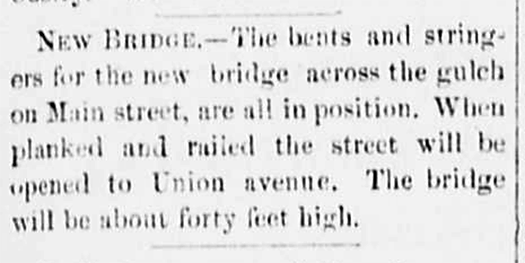
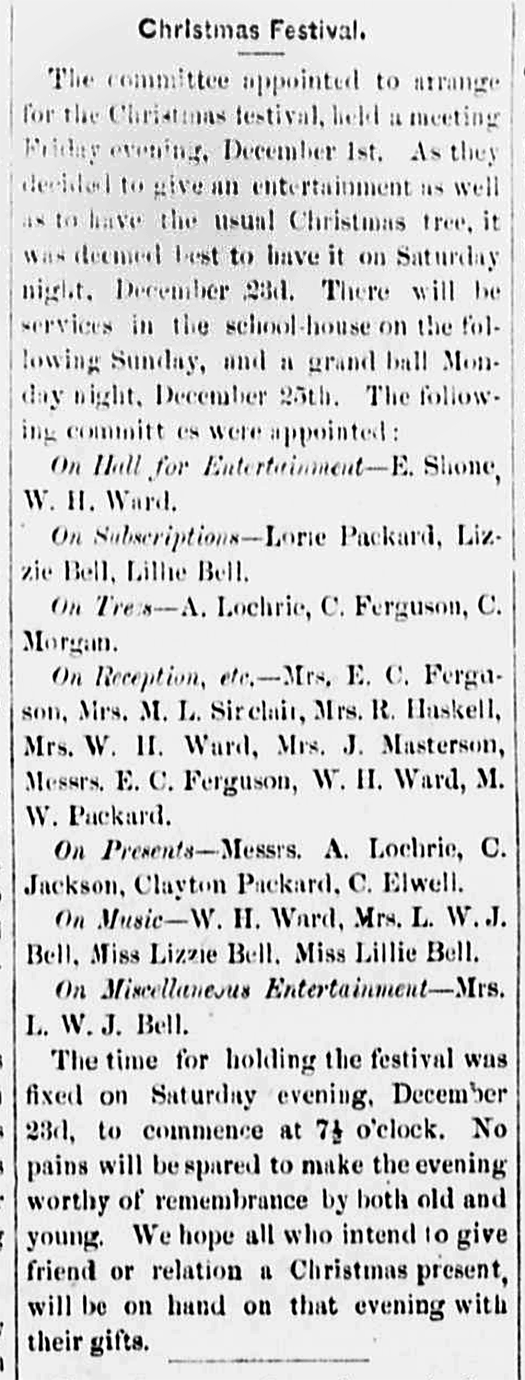
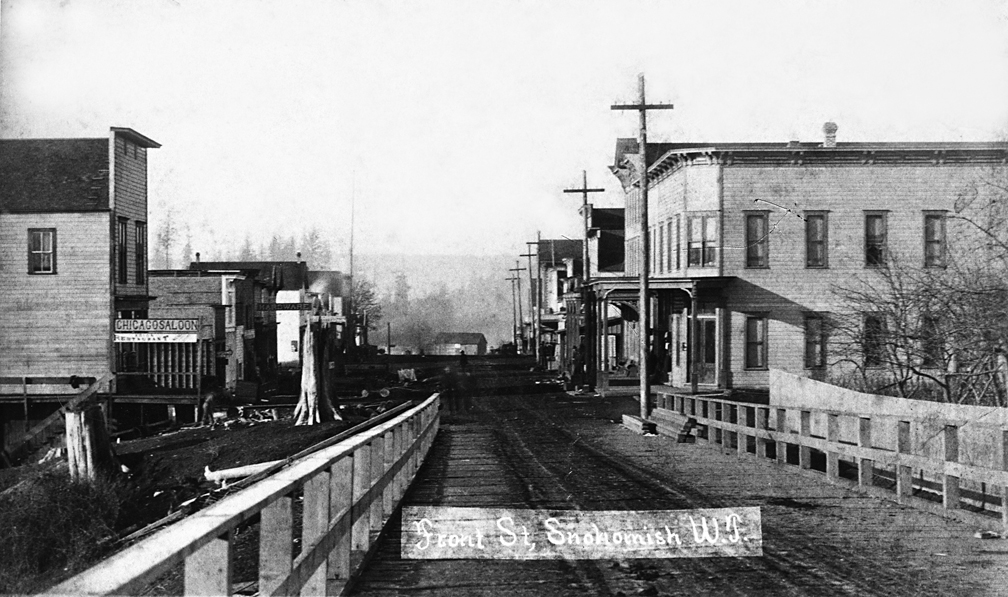
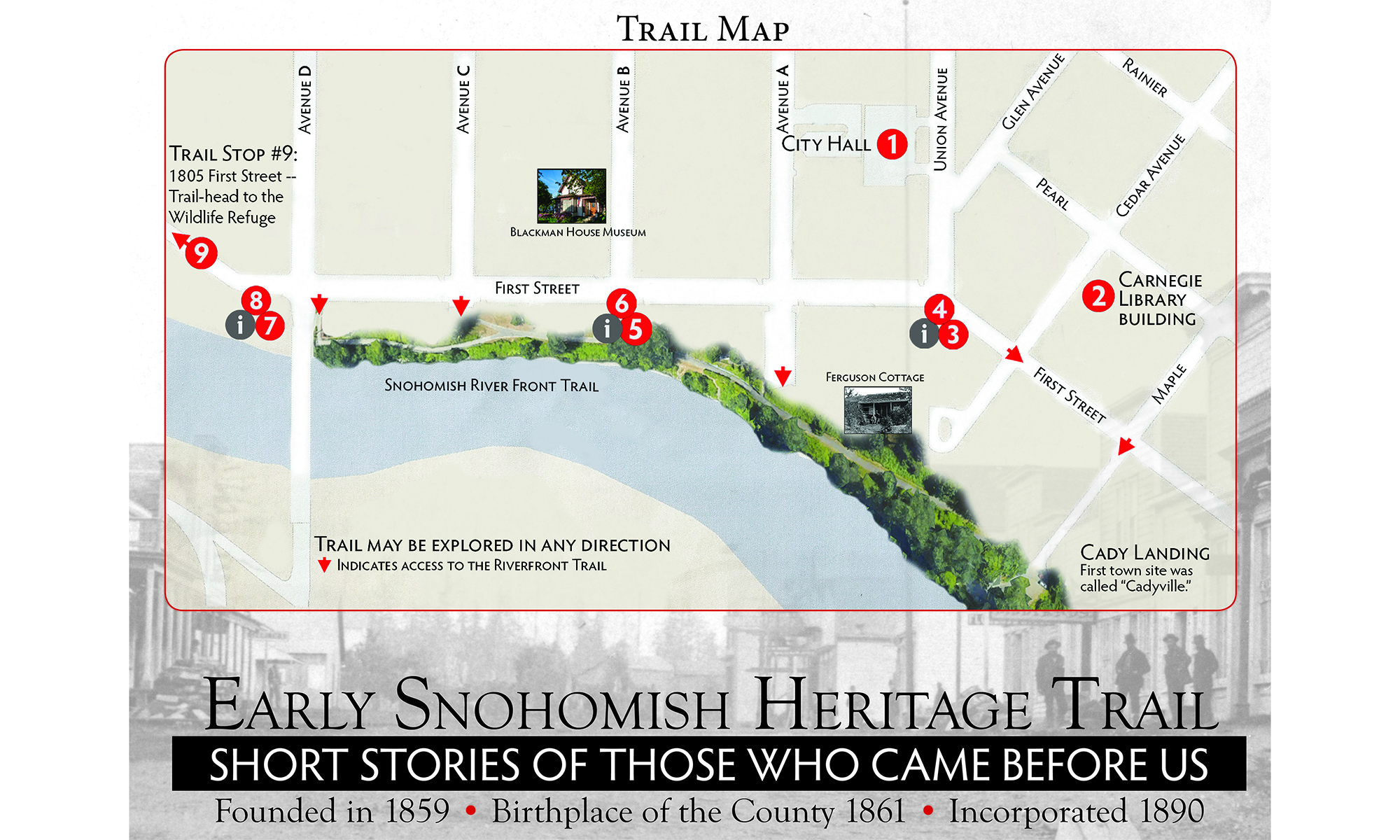
A 501(c)(3) NonProfit Organization Since 2014.



Featured Image: Ferguson Cottage, 2007. Rebecca Loveless (standing) purchased the structure in 1997 not knowing she had just bought the oldest house in the county. Sheryl Maultsby (seated) committed to renting the house at first sight, even in its rundown condition, then waited patiently until she could move in. Published in “Early Snohomish,” page 81.

A short movie I made in 2015 about the restoration of the historic structure by Rebecca.
. . .
Featured Image: E. C. Ferguson in his real estate office on First Street — note the painting of the Snoqualmie Falls above the door.

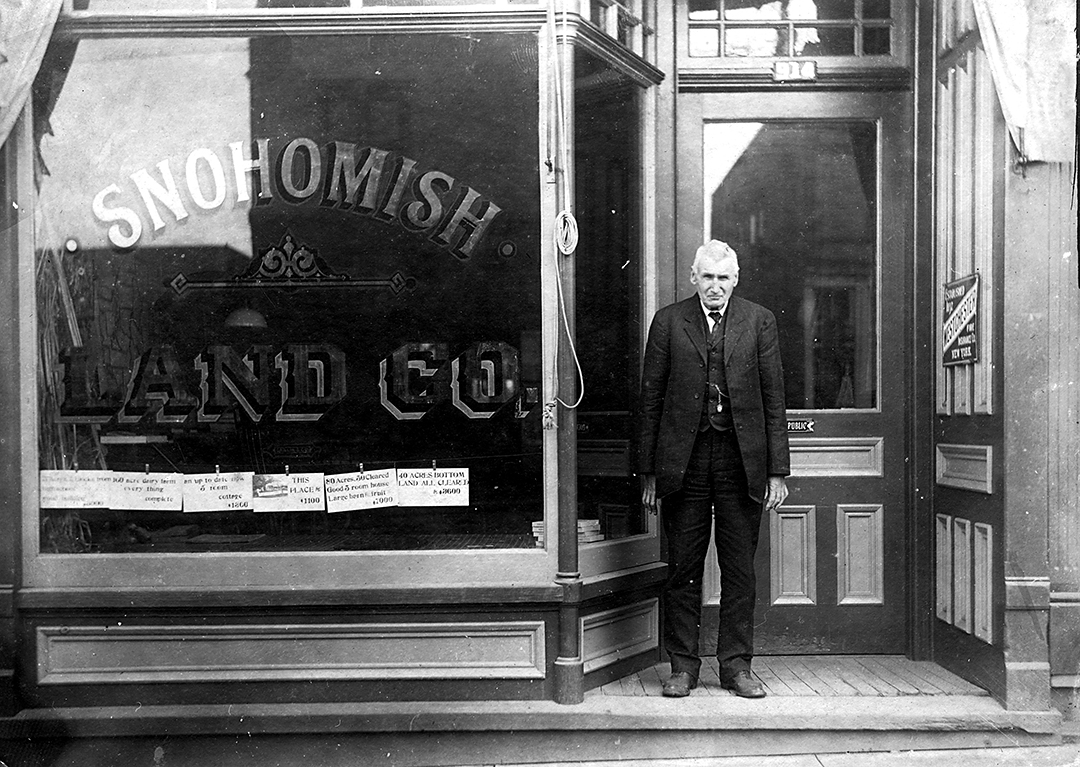
A photograph of the SS Neille was posted in the August post.
Learn more about E. C. Ferguson at Stop #1 of the Early Snohomish Heritage Trail pictured on the Home Page.
. . .
The first fair was held in E. C. Ferguson’s Blue Eagle Saloon in 1874. It’s pictured left of center in the photograph above, circa 1885. The Ferguson Cottage is further to the left, the Jackson Wharf, center, and the Sinclair store to the right.
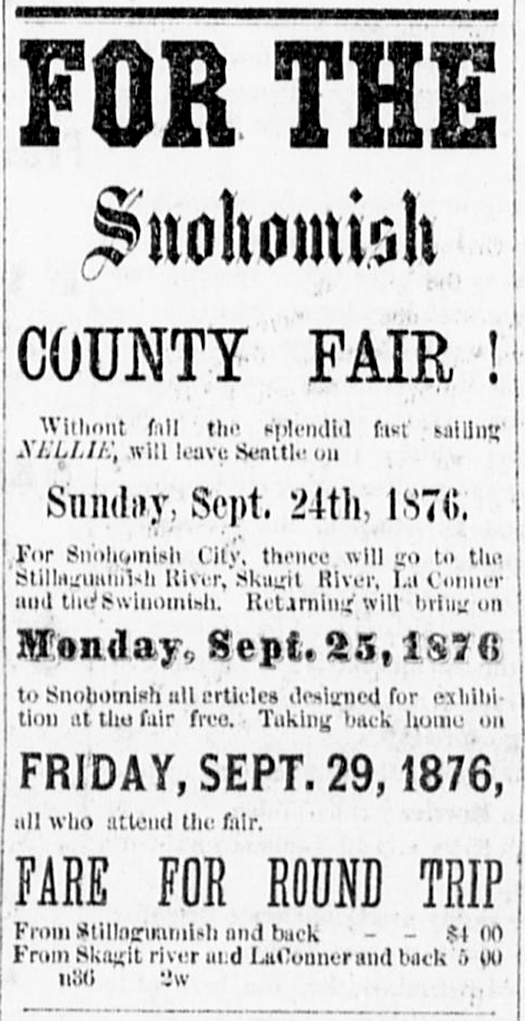
On September 16, 1876, in his new newspaper The Northern Star, underemployed frontier lawyer Eldridge Morse (1847-1914) publicizes the first agricultural fair of Snohomish County, which was held two years earlier in the county seat, a small settlement also named Snohomish. Morse has brought a used printing press from Olympia to Snohomish and taught himself to set type. Drawing on his experience as a farmer, coupled with an imaginative sense of the county’s agricultural potential and the inspirational drive of a community activist, Morse plants the roots responsible for what will become the Evergreen State Fair, held every August for 12 days in the Snohomish County city of Monroe.
Continued at Historylink.org
. . .
“If any of the early settlers arrived on foot, it would have been Isaac Cathcart. Pictured here as published in The History of the Pacific Northwest: Oregon and Washington, the large-framed Irishman, recently from Michigan, had been working in the county since 1869, felling trees in the isolated logging camps. Within four years, he had saved enough money to build the Exchange Hotel.”
Early Snohomish, Arcadia Publishing, 2007
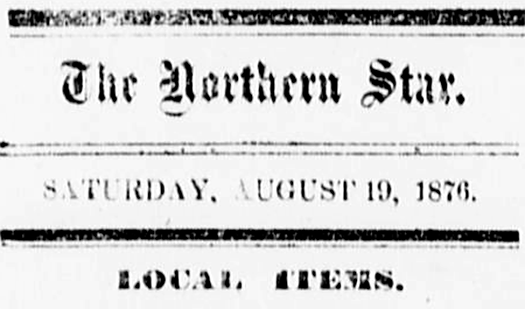

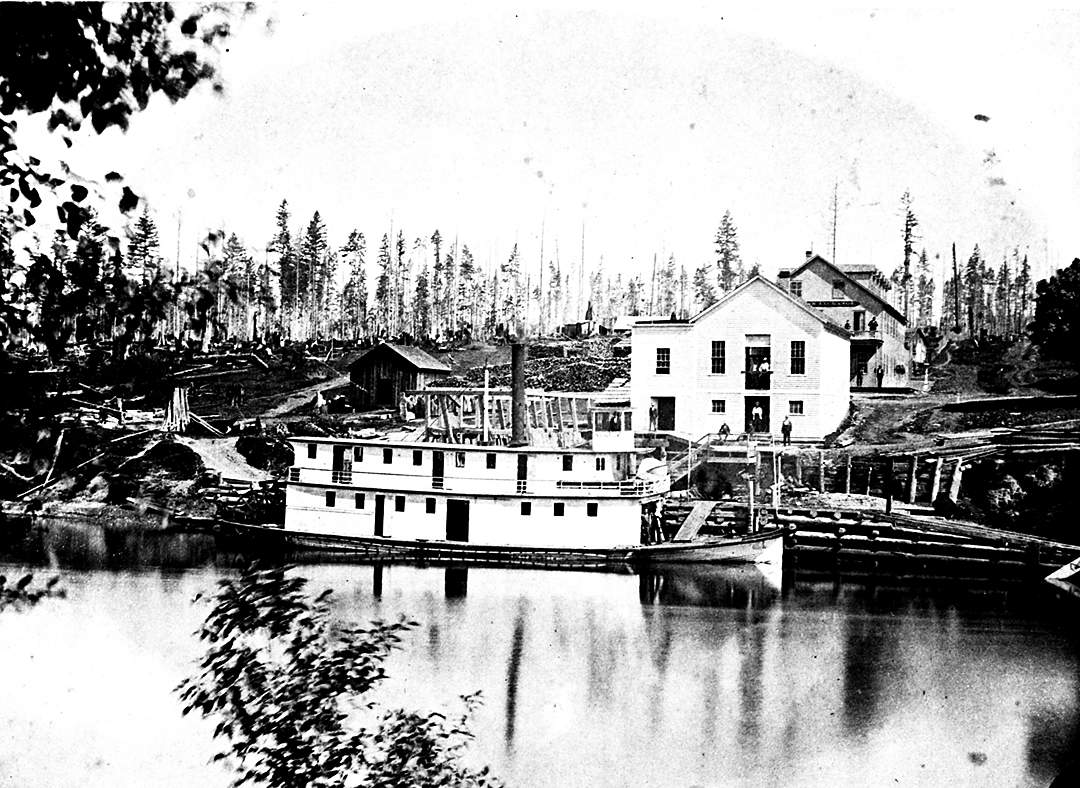
Another early photograph of Snohomish jam-packed with historical details. Unfortunately, we don’t know the name of the photographer but can assume it was taken on the occasion of the year-old Stern-wheeler “Nellie’s” addition to the list of steamships serving the young city of Snohomish. Snohomish County, An Illustrated History, edited by David Cameron who also contributed a two-page list of “Steamboats in Snohomish County” on pages 87-88, emphasizing the vital role the boats played in the development of the territory. In the immediate background is the Ferguson Building and beyond is Cathcart’s Snohomish Exchange Hotel — both are featured in the story of Cathcart’s wedding party to an unnamed woman from Seattle.
. . .
Featured Image: Cathcart Opera House/Atheneum Hall being torn down. Photo by Picket, c. 1910
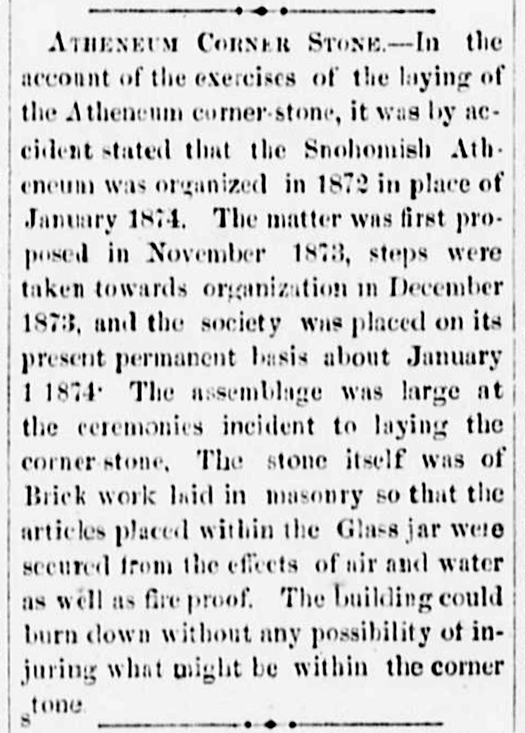
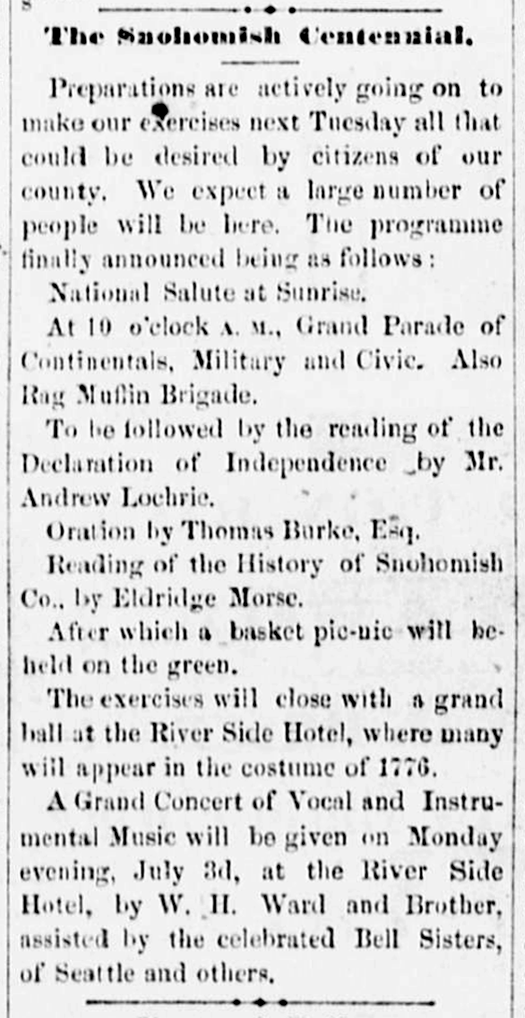
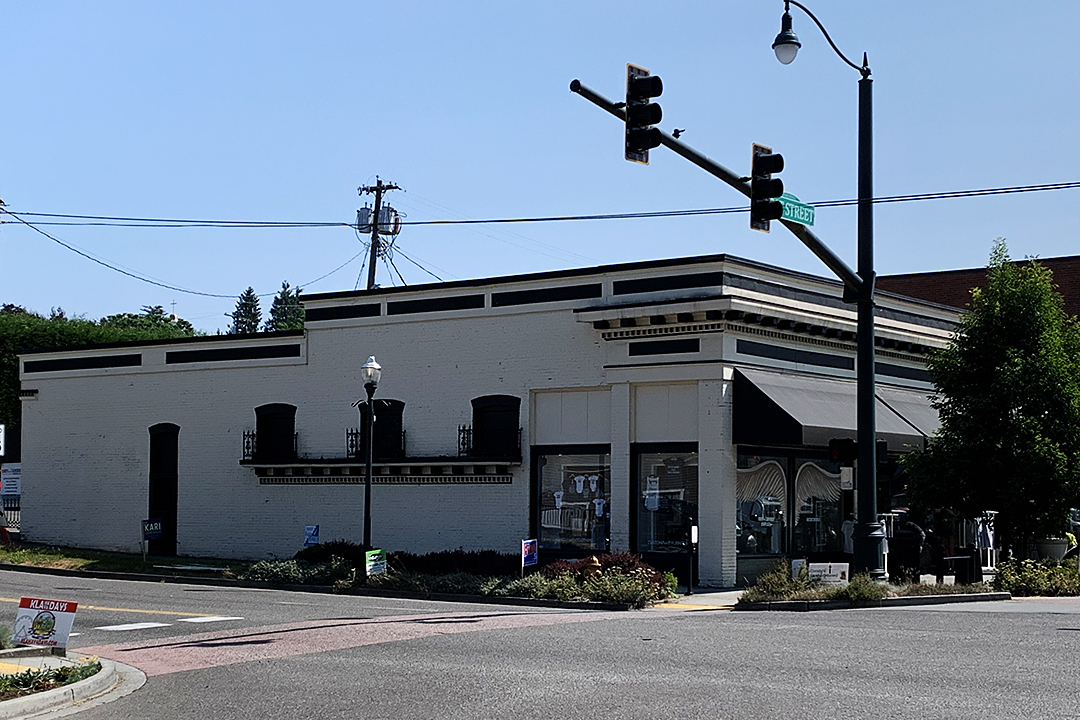
The inscription in the featured image above reads: “Built in 1876 by Issac Cathcart — Wholesale + Retail General Merchandise for Loggers + Settlers, Torn down in April 1910, by Wm. Cathcart for a new brick building on the sight (sic).” The image is signed “Picket” in black ink in the right-hand corner which we assume is Lee Picket, a resident of Index, WA where the family home was preserved and is used by the Index Historical Society — well worth a visit.
No record of the cornerstone has been found.
. . .
Learn more about Early Snohomish at Stop #2 of the Early Snohomish Heritage Trail pictured on the Home Page.
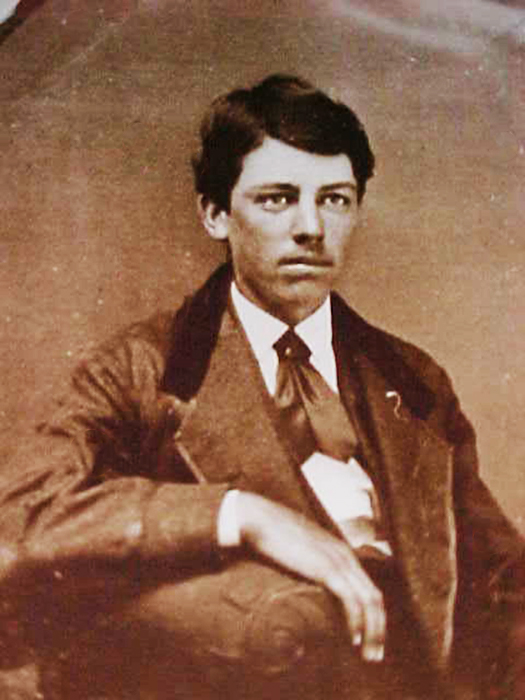

“and we become the children of the past, as well as the parents of the future.”
Eldridge Morse
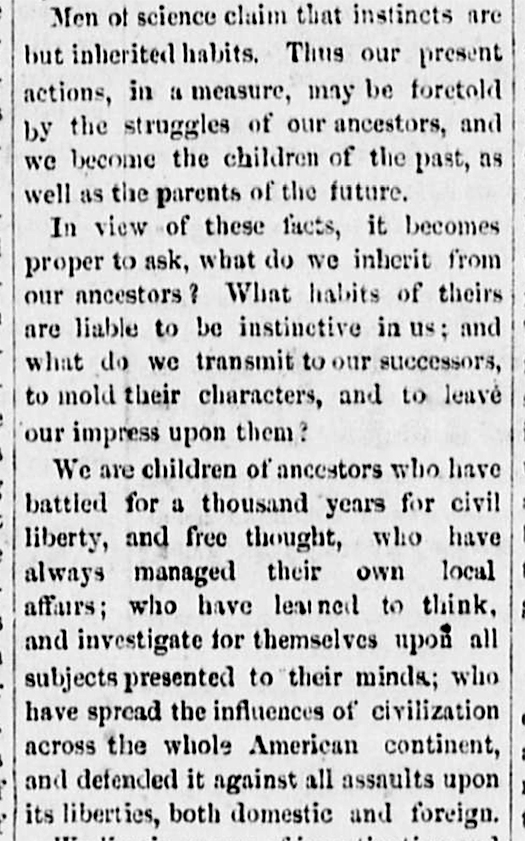
And what is the work by which we hope to ‘leave behind us, Footprints on the sands of time?'”
Eldridge Morse
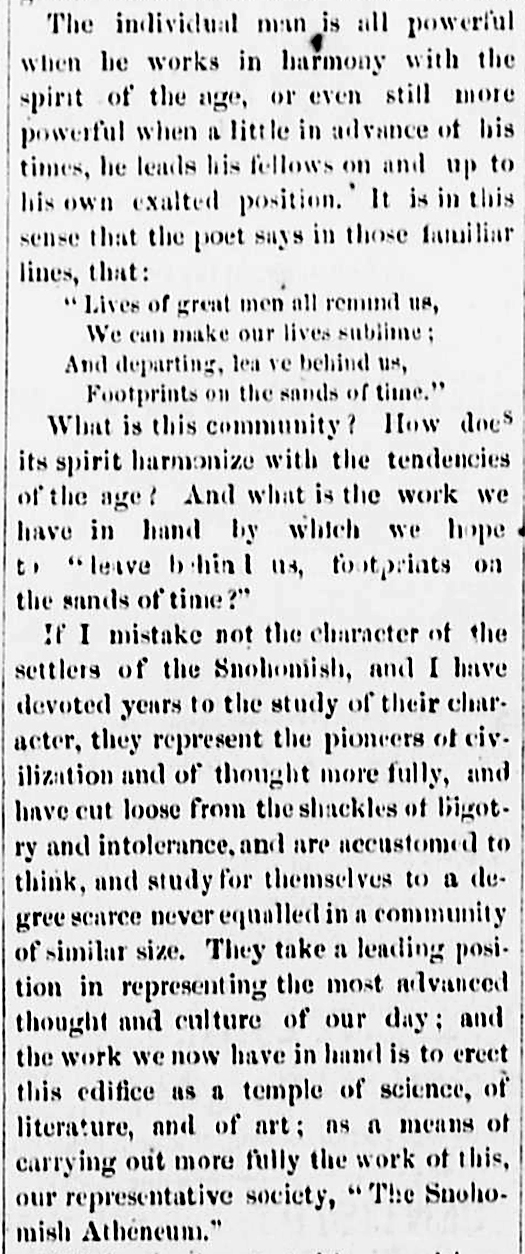
“… your noble work [will] be perpetuated forever and ever.”
Eldridge Morse
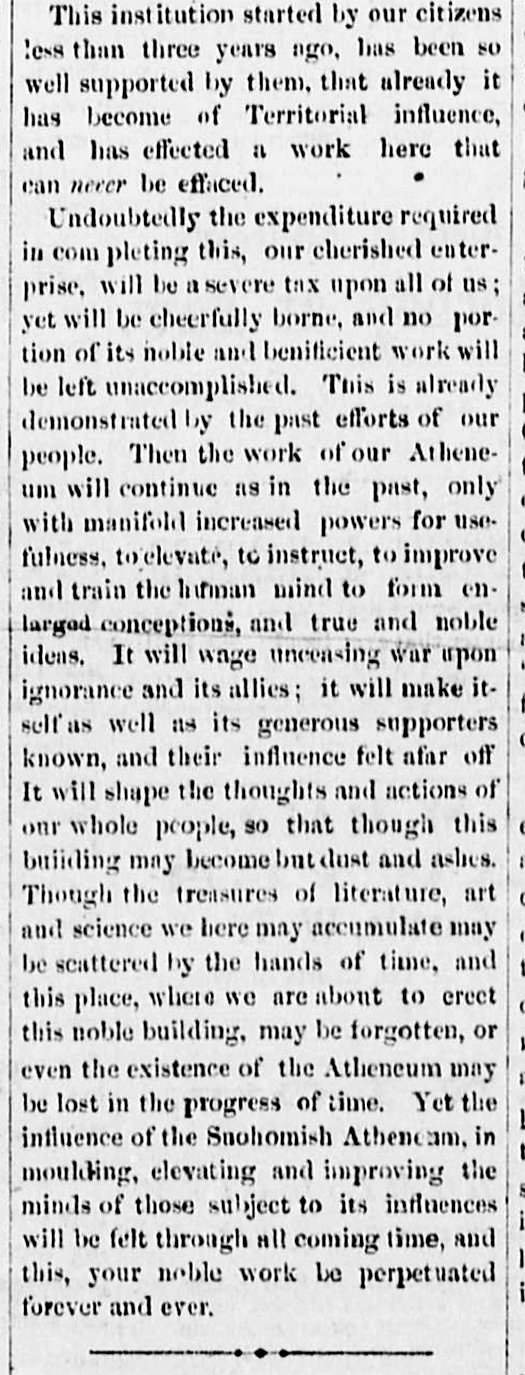
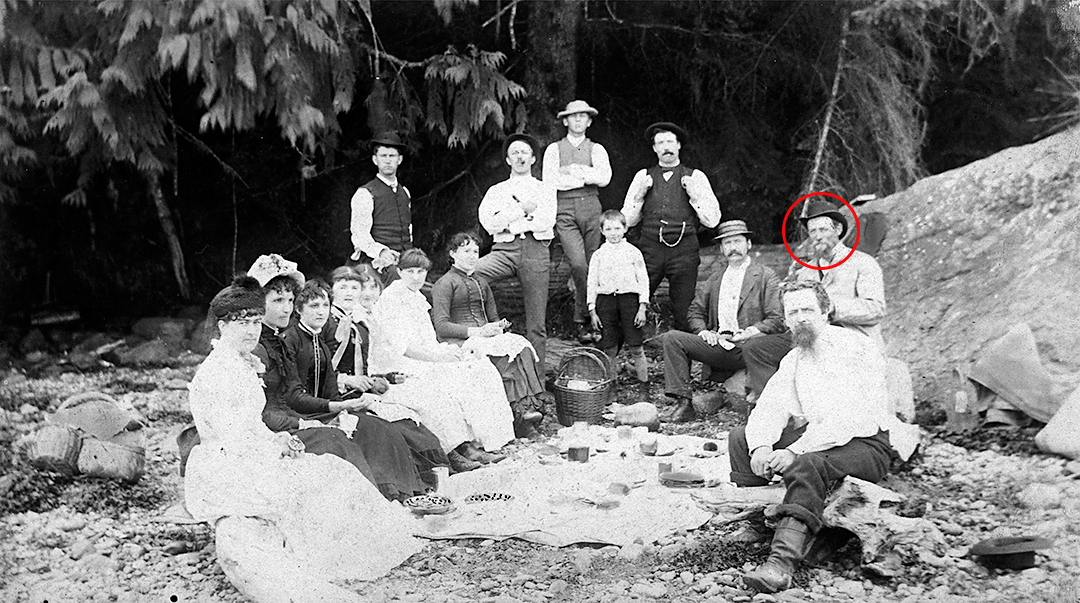
Learn more about the Snohomish Elite at Stop #2 of the Early Snohomish Heritage Trail pictured on the Home Page.
. . .
The Featured Image above of the renovated Carnegie Library building was taken Sunday morning, May 9, 2021; an interpretative sign for Stop #2 of the Early Snohomish Heritage Trail will be installed at this location.
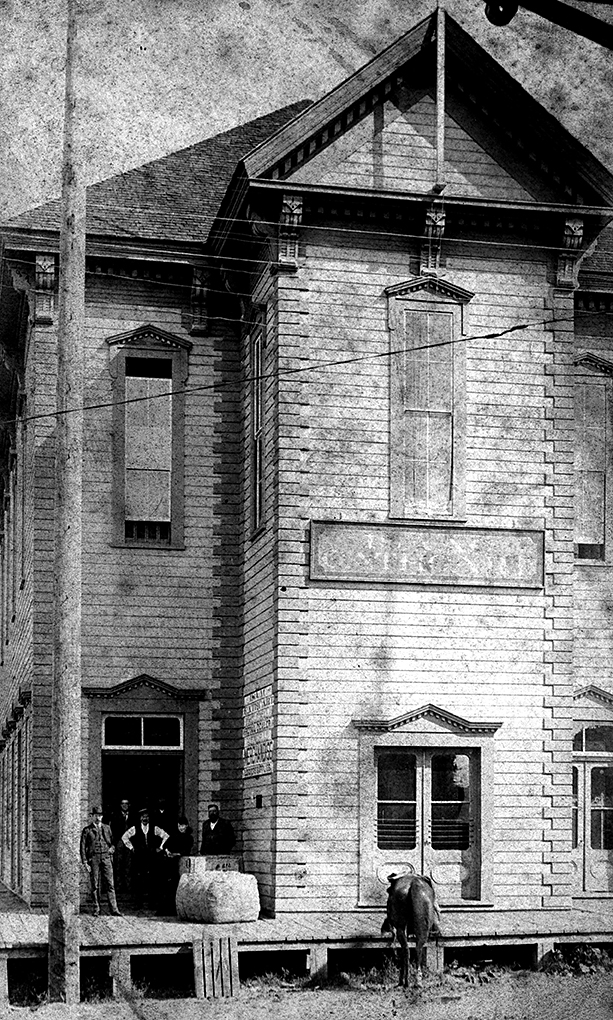
The Snohomish Atheneum’s inspirational leader was Dr. Albert C. Folsom, scientific, literate, and a former army surgeon with experience in the Civil War. In his 40s, he settled in Snohomish around 1869 with a broken heart from a failed marriage, but also with over 1000 fossils, gems, and bones. He and Eldridge Morse led the way toward building a museum to exhibit his collection and provide a place for meetings. Moreover, the elite of frontier Snohomish pooled their private collection of books to form a lending library of some 300 volumes, including Darwin’s Descent of Man (1871). The women members formed their own club and raised funds to purchase a piano for the building. It was the first piano of Snohomish, and it is still available for use in the library today. Issac Cathcart opened a store and upscale saloon on the ground floor — that appears to be him standing on the right of the group.
(From Early Snohomish, page 45.)
. . .
The Featured Image was published in Northwest Magazine, August 1890.

Learn more about Mary Low Sinclair at Stop #4 of the Early Snohomish Heritage Trail pictured on the Home Page.
And learn more about the Blackman Brothers at Stop #5 of the Early Snohomish Heritage Trail pictured on the Home Page.
. . .
Featured Image: Snohomish Elite Outing, circa 1885.
Native-operated dugout canoes were vital to the growth of early Snohomish transporting both passengers and cargo.

The Northern Star 25 March, 1876
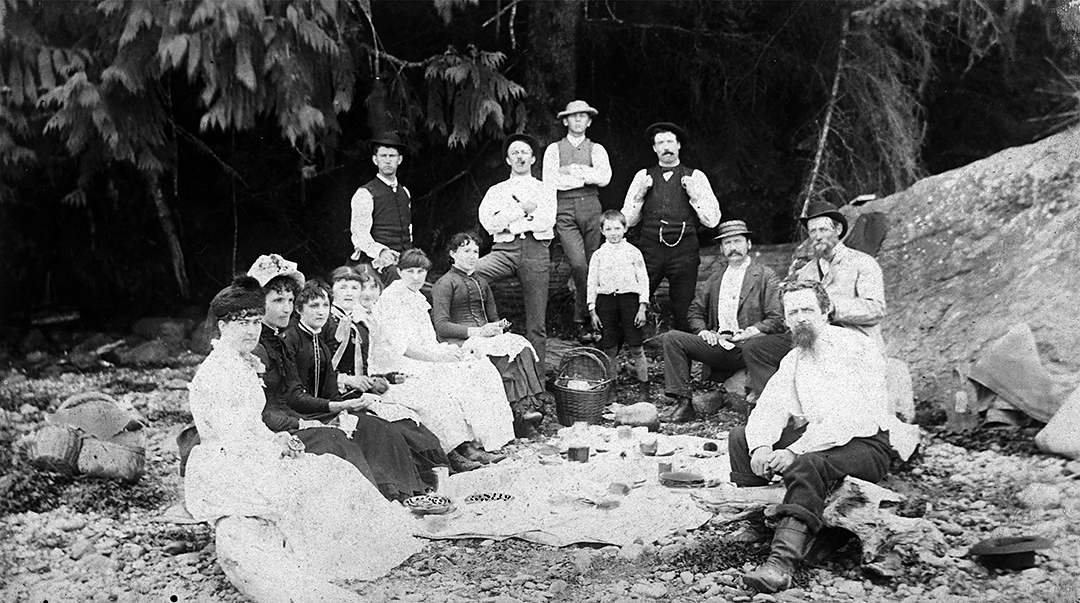
Snohomish Elite Picnic, circa 1885. On the left is the photographer’s wife, Margaret Horton; next to her is Jennie Wilbur. Her husband, Lot Wilbur, is the first male on the right; and behind him is Eldridge Morse, the editor, and co-founder of the Northern Star, where he used the term “Snohomish elite” to describe the leaders of the community. Both photographs are by Gilbert Horton, courtesy of the Snohomish Historical Society. (Tap image to enlarge)
Learn more about the Wilburs at Stop #8 of the Early Snohomish Heritage Trail pictured on the Home Page.
. . .
Featured Image: Alki Point Monument Dedication, 1905. An eight-year-old Mary Low traveled with her parents from Indiana, over the Oregon Trail all the way to land’s end at Alki Point, arriving on November 13, 1851. Mary, pictured above on the right is mentioned in the article below. With her, from left to right are Lenora Denny, Carson Boren, Mary Denny, and Roland Denny — all family names of the founding settlers of Seattle. (Photograph courtesy UW Special Collection Peiser 10088.)
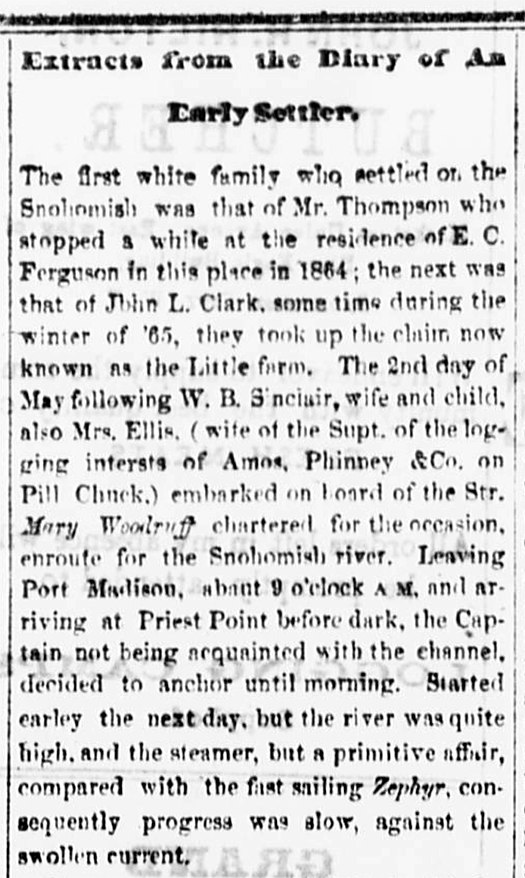
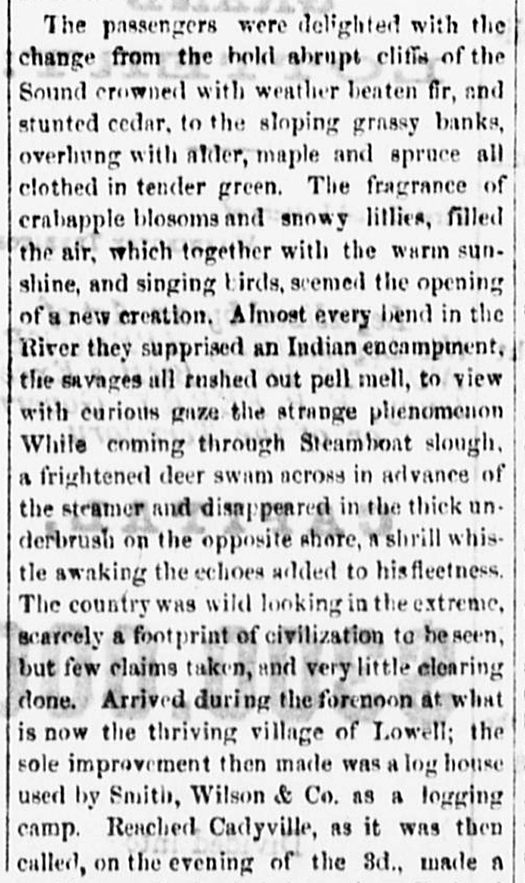
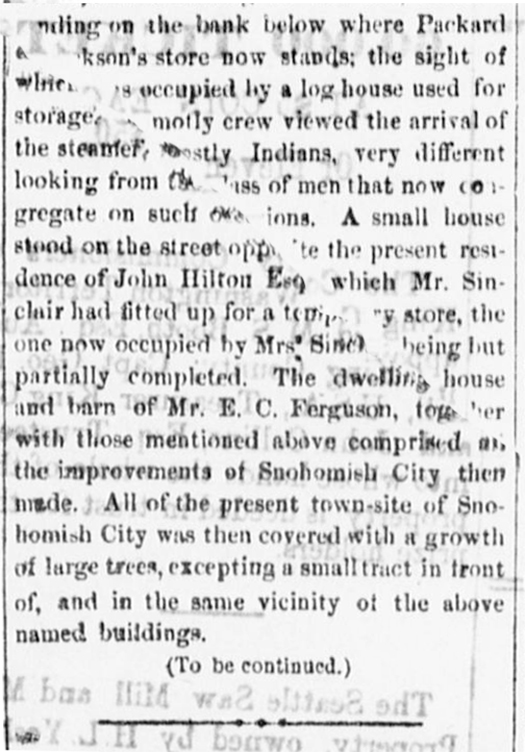
The Northern Star, Volume 1, Number 2, 22 January 1876
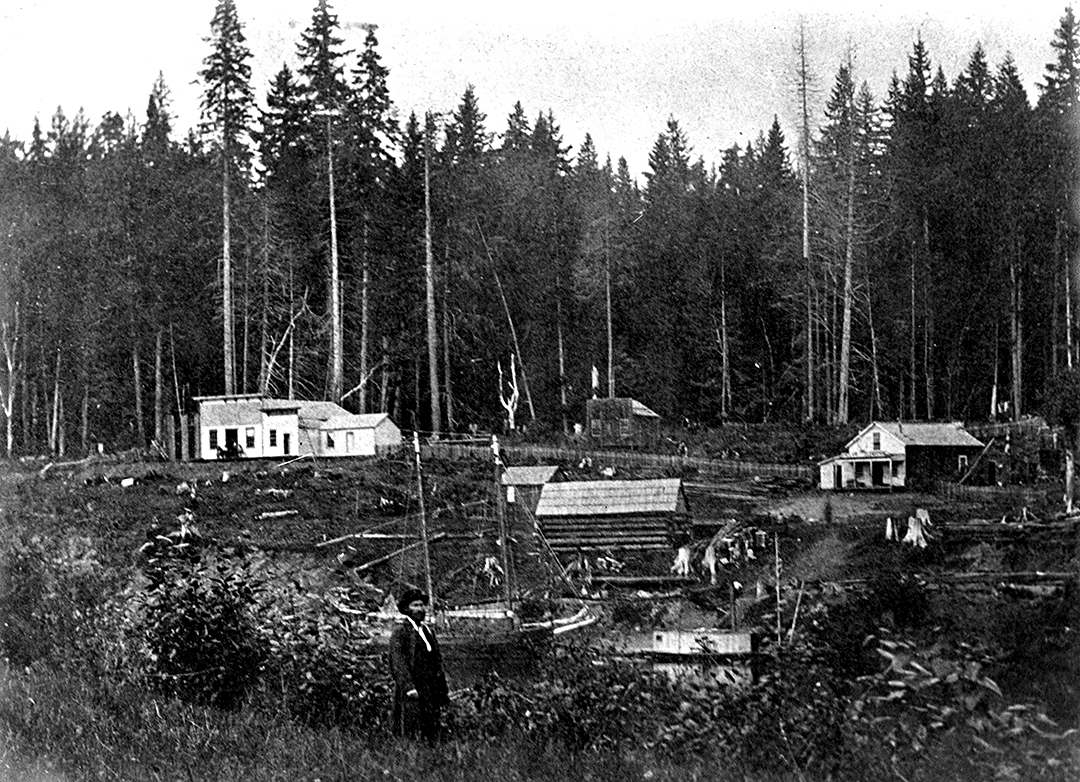
The County Seat, 1865. The first known photograph of Snohomish is attributed to E. M. Sammis, a New York photographer working in Seattle when he took the only studio photograph of Chief Seattle. A newspaper account, in 1865, tells of his trip up the Snohomish River on his way to “Washington Territory’s greatest wonder, The Falls of the Snoqualmie.” The structure on the right is the Sinclair store with a home in the back where his wife Mary Low started a school. On the right, across the path to be named Cedar, is E. C. Ferguson’s Blue Eagle Saloon. There is some speculation that the man standing in the foreground is W. B. Sinclair.
Read more about Mary Low Sinclair at Stop #4 on the Early Snohomish Heritage Trail pictured on the Home Page.
. . .
Featured Image: Top half of the front page of Snohomish’s first newspaper, the report on Christmas pictured below was published on page 3 under Local Items.
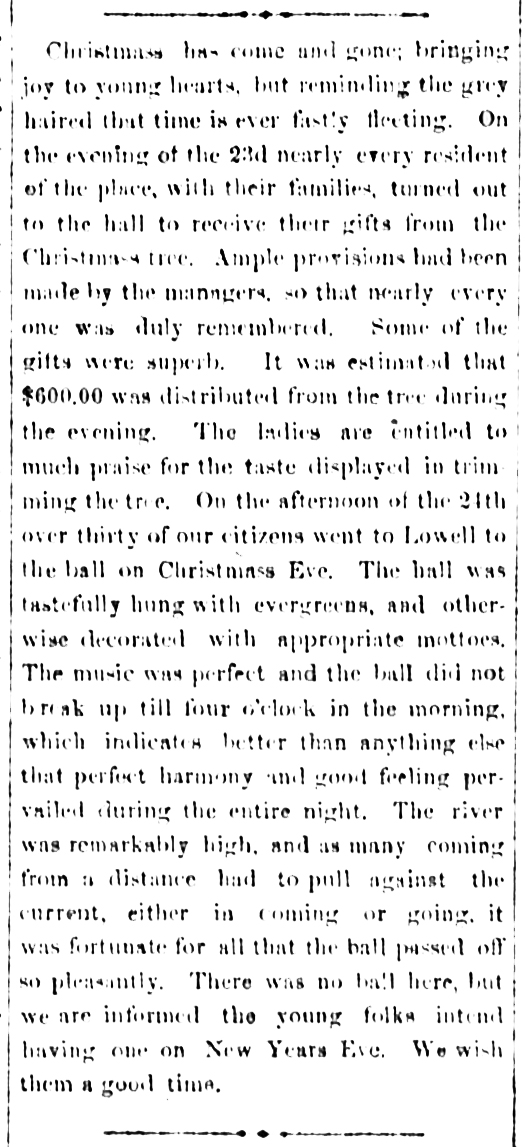
The Northern Star, Volume 1, Number 1, 15 January 1876
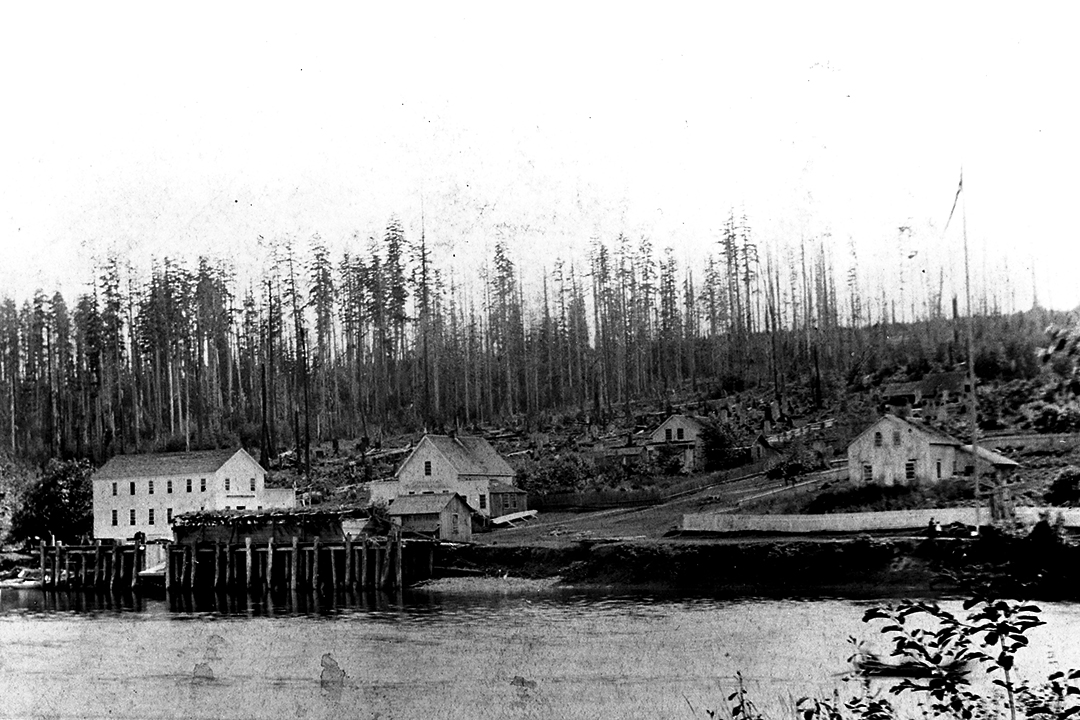
Lowell on the Snohomish River. Photograph by Gilbert Horton, circa 1885, courtesy UW Special Collections 12433.
A popular activity of early Snohomish residents was taking moonlight excursions six miles downriver to Lowell for dancing on the wharf, weather permitting, otherwise in a hall, as they did on Christmas Eve in 1875, according to the first issue of the Northern Star.
Read more about our first newspaper at Stop #7 on the Early Snohomish Heritage Trail pictured on the Home Page.
. . .
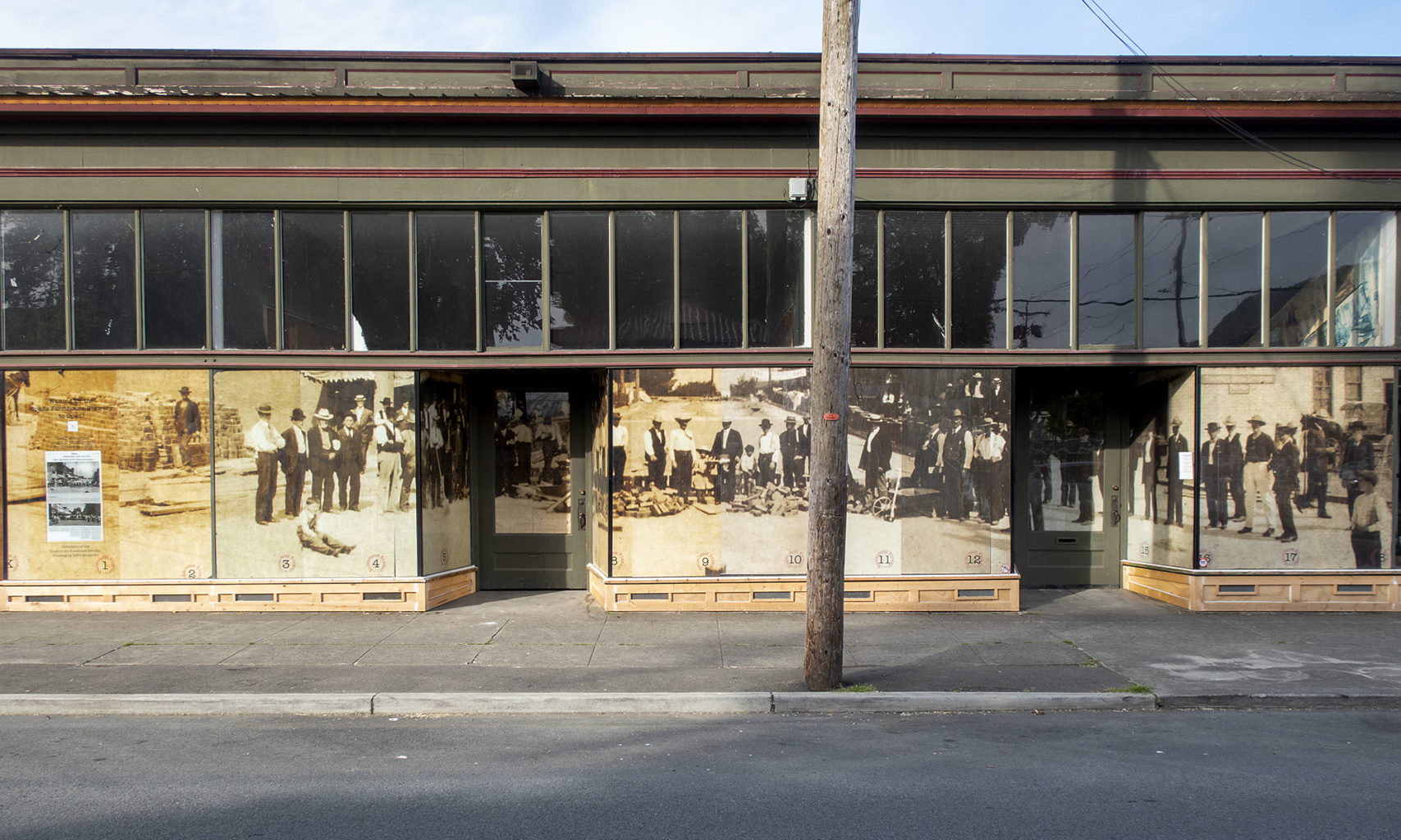
Featured Image: The NOW shot of the renovated brewery, bar and cafe on 12.06.2020; pictured above is the THEN shot (explained below).
Mellisa Spada contacted me to learn what I might know about the former Stewart’s building at 709 First which they purchased with plans to expand their family business, the Spada Farmhouse Brewery. I was no help but suggested we search the old newspapers once the library reopens.
Then, pitched her the idea of replacing the brown paper with inexpensive bond paper prints of a historic image divided into sections. It’s an idea that comes to me every time a store on First Street changes hands and the windows are covered with kraft paper which eventually loses its battle with gravity and looks a mess!
Bill’s Blueprint in Everett prints color and black & white images up to 36 inches wide by any reasonable length, according to the website, starting at 35 cents a square foot for white bond paper. In the case of the 709 First building with 83-inch tall windows, each section of a photo mural would cost under $10 dollars, Mellisa did the calculations and came up with 19 sections. My pitch to Mellisa was for her to pay for the materials and I would donate the labor — (I wasn’t sure if the idea would work).
The prints were pasted to the windows with a thinned down wheatpaste — a method adopted from graffiti postering — it’s not intended for close-up viewing. Best of all, it’s ephemeral, like theater, after the run of performances we strike the set, said the former scenic designer.
The historic photo used is one of my favorites by Gilbert Horton taken in 1908 of an event marking the laying of cobblestones on First Street to replace the wooden planks. I wrote about it in 2008, when the “Snohomish Then and Now” column was published in the Tribune.
The “set was struck” during the last week of November and the windows cleaned to their reflective glory. When I showed up at the Grand Opening on December 4th, Mark Spada was checking his phone, I shared my congratulations. He confessed that the restrictions on indoor dining gave them room to breathe. The generous size room is limited to 120 people he said, then added, “can you imagine over a hundred people in here?”
He had a point. But one day the handsome space will be full of people, often. Just across First Street is the renovated Carnegie Library building getting close to its own Grand Opening.
This block of First Street is sure to become the “top-of-the-town!”
. . .
Featured Image: Dorothy Devore in “Hold Your Breath.” The story below published in the October 16, 1924 issue of the Snohomish County Tribune.
. . .
Brown’s Theater Crowded As Opening Night Pleases Huge Audience, Two Full Houses
With more than 1,000 people in attendance, Brown’s Theater opened to the public Thursday evening.
Long before the opening hour, seven o’clock, an anxious crowd of theater fans blocked the street, awaiting the opening of the doors. This despite the inclement weather of the evening.
At five minutes after seven, every seat in the house had been taken, and the good-natured gathering spent the moments before the opening admiring the beautiful interior of the place.
Promptly at 7:30 lights were dimmed and the introduction began. This proved a novel thing. Instead of appearing on the stage and talking to the audience, Mr. Brown had a movie of himself made, showing him “close up” addressing a gathering. His words of welcome were then reproduced on the screen. At the end of the short film, a “hook appeared dragging him from the platform with the words “Let’s Go.” With that the program proper of the evening began.
Several excellent movie films followed, interspersed just before the big picture of the evening by a clever singing act in which James N. Mount and Mrs. Gladys Wallage appeared in several selections from modern songs. They were very well received being encored again and again.
The evening developed into a rather gala occasion for the entire city, with restaurants and confectionery shops filled to overflowing after the show.
Published in the Snohomish County Tribune, October 16, 1924
. . .
Curious, no review of the “big picture of the evening,” Hold Your Breath –but your review is welcomed in the comments, where you will find a wonderful story from the Snohomish childhood of Candace Jarett attending a screening at the Brown Theatre with her class from Central School.
Follow this link to learn more about the movie.
. . .
Featured Image: “Why Not?” Photo illustration by the author.
A lingering notion I’ve had, probably since Early Snohomish was published a dozen years ago — if I were to write a sequel I’d call it Modern Snohomish.
In June 1926, Snohomish residents approved, by only three votes, the construction of a new fire station on the corner of Avenue A and 2nd Street to replace the 19th-century wooden building referred to as a shack in the news accounts.
Included in the vote was the construction of our first City Hall with offices for the police and a jail in the basement.
By then the new Lon Brown Theatre, a 40×100-foot structure of concrete, built on a lot purchased from the city for $2,500, and snuggled up close to the ten-year-old First National Bank (our first “fireproof” building) had been screening movies for two years. The Iron Horse, John Ford’s “blazing trail of love and civilization” played an extended run that past September.
Mac Bates, native son and retired middle school teacher, begins his remembrance of the Brown Theatre, as found on RootsWeb (posted in 2002), like this:
Every day as I cross the bridge into Snohomish, I turn onto First Street, pulled ineluctably by memory. I don’t really expect to see Schott’s Meat Market, Snohomish Drug, Mel’s Delicatessen, or J.C. Penney instead of the antique stores and boutiques, which have breathed life into downtown Snohomish, but, invariably, as I turn onto Avenue B, I look to see what’s playing at the old Snohomish Theater. Of course, nothing is playing. There have been no coming attractions for almost three years when the last movie ended, the credits rolled, and the screen went black forever.
Jackhammers three years ago leveled the lobby and exposed the darkened theater. Rows of sticky, soda-stained seats were ripped from the floor. For a few days, the patched movie screen was exposed to the last warm light of fall before workmen dismantled it, leaving a gaping black hole on First Street and in my heart.
I had never been backstage and had had little desire to see what lay behind the curtains. The screen was my window to the world of romance, adventure, terror, and fantasy. Movies enchanted me. The images came not from the projector but from behind the screen if one dared look (and I could not), an ethereal vapor spiraling out over the Snohomish River, wisping above cornfields and grazing cattle, and soaring over the forested foothills to Hollywood where almost anything seemed possible.
Download the entire story as a pdf file.
The late Carroll Clark, who posted Mac’s story on Rootsweb, I met in connection with the Annual Mother’s Day Vaudille Show produced by Eleanor Leight to benefit the Snohomish Historical Society for many years. His granddaughter was a featured dancer in the show along with other key dancers nicknamed the “Dawn Patrol.” In 2004, I followed the creation of the 26th Annual show with the documentary: To Dance with Eleanor.
Indulge me with a fantasy that could have been: The renovation of the Lon Brown Theatre in the 1970s for the Annual Mother’s Day Vaudville Show! Instead of screening the Northwest Premiere of Deep Throat, as told in Mac’s story.
Eleanor’s show was presented in the PAC — the high school’s Performance Art Center until a new center was built with many tax-dollars — its use was too expensive for Eleanor’s annual show to continue.
. . .
A heartfelt thanks to Mac Bates, and your memories of the Brown Theatre are encouraged, please comment below.
Formally Titled: “DRB Meeting, Wednesday, August 12, 6p.” Nothing is certain in this Age of Zoom Meetings except the recordings.
First, one auditorium becomes two — the main floor and a balcony; then the lobby, balcony theater, and the auditorium were destroyed for a retail operation — a tourist trap; then the marque from the 1920s was replaced with a new, yet vintage looking sign with the name Pegasus; and, during a week in May 2020, the last straw — the fly-loft was destroyed and replaced with a “penthouse!”
The Lon Brown Theater is Dead to Snohomish Residents.
Long Live the Lon Brown Theater in Their Memories!
Please contact me with your memories of watching movies, dancing on the stage, and especially if you have pictures (i can scan them while you wait — make an appointment: 206.914.4075 Voice & Text; hello@snohomishstories.org.
Easiest of all, leave a comment below.
Please check your scrapbooks, your shoeboxes of photos and tell your stories — the library is closed to research we need to crowd-source this mission!
Coming in September will be the rich remembrances of Mac Bates, son of the late Bill Bates, once the editor of the Tribune.
Let me add yours.
And in October, the first movie screened on October 9th, 1924, “Hold Your Breath,” will be posted in celebration of the theater building’s 96th anniversary.
You provide the popcorn.

The red circle indicates the location of the unfinished “penthouse” overlooking our River Front Trail, with its oversized windows, like a watchtower. (Click to Enlarge)
. . .
Featured Image: Theater Head Block, collection of the writer.
“Head blocks are overhead multi-line blocks used for the lift lines and operating lines.” [Wikipedia]
“The bones found us! It was a f-u-c-k-i-n-g shower of bones!” Said the Boss, who was a fast speller.
Suddenly his arms went up, palms cupped, head back, eyes wide open — an act of submission to a higher power — as portrayed in the old movies, I thought.
Very slowly, Boss floated his arms down to shoulder height and aimed both index fingers at Jake, who turned around from looking out the huge window, that towered over him, to face Boss, with a sharp setting sunlight to his back.
Boss shuffled left and right looking for a view of Jake’s face, giving up, he began, “Jake, here, on the first day on the job, went up the old rod iron ladder to the rails just below the ceiling, what do you call all that?” he asked, looking at me.
The “Grid-Deck” I told him. “Was it made of metal …?” I tried to ask.
“When Adventure Boy, here, gets to the top of the ladder, the piece of shit comes off the wall, banging against the metal thingamajig….
“Grid-deck. Sounds like it was made of metal,” I said. “Amazing, an iron grid-deck in the 1920s,” I started but was cut short by the Boss who was on a roll (playing a role, for sure).
“Whatever, the ladder jammed against it and Adventure Boy, here, skidded down the ladder, ripping the shit out of his hands, but was almost beaned by an iron pulley thing that went sailing past him landing with a startling, deep thud that shook the goddamn flimsy stage house walls.”
“No one moved,” continued Boss, “we stood there looking up into the darkness of the fly loft.
“I swear I heard footfalls up there,” said a young-looking Eric, kind of whispering — looking at me with a disconcerting stare.
“When the bones began to fall,” said Boss, making sure everyone knew he was reaching the turning point of his story, “it was as if someone, or something … was, I don’t know … was … settling a score?”
“Know what I mean?” he said turning to look at me.
The Boss overused this tag line — as if I knew anything about it — I just nodded in the affirmative.
“Now is not the time, nor the place to be talking about this,” spoke up Jake, turning again in the light to face the Boss as a shadow or silhouette.
I could see he had his shirt off, built like a modern movie star, I could sense he was proud of his look, topped with a fire-engine red head-band corralling his wild blonde locks. He never did take his gloves off, come to think of it.
The bowl of burning Blue Dream was opposite me, across a loose, semi-circle gathering. Jake was on my right, turning towards me, he watched my eyes as he spoke.
“The fly loft walls were dangerously water damaged and I shit you not,” Jake said, sotto voce, “it was ready to collapse, with the iron grid coming down on all of us — instant decapitation! The failure of the ladder was the only warning I needed.”
Our intense eye contact was (thankfully) broken when Jake slowly turned toward the Boss, then on to Eric, and to the fourth crew member, whose name I didn’t get, Jake continues, “fortunately, the fly loft came down by our hands as fast as we could — you can wipe your ass with the permit!”
“Was there really, a shower of bones?” I asked, with air quotes.
. . .
COMMENTS WELCOMED BELOW
Featured image: The red circle locates the black room where the fly loft of the former theater building once stood.
Well, I thought they were talking about the structural parts of the building — its Bones. “This old building still got good Bones,” the crew chief would say, way too many times, accompanied by an obvious round of eye contact between the other three crew members who called him “Boss.”
The knowing looks between them seem obvious in hindsight but my mind at the time was on the 30-foot drop to the floor below, the old stage floor. The unfinished floor above ended at a large opening with a quickly built staircase along the west wall. The absence of a handrail gently pushed me toward the wall and I hugged it close, one step at a time, all the way up.
But the view!
High above the stage floor of the old theater, built where the fly loft once held scenic flats, painted drops, even a thunder machine, and a snowfall sling of black velour, the view took in the Cascade Mountain Range to the left, the Snohomish River Valley straight-ahead and the watery planet of Puget Sound to the west.
Plus it was a super bright, super clear day with a spectacular stack of clouds hovering just above the bright, thin line of the horizon. A burning bowl of sweet bud was passed to me and I welcomed the opportunity to experience this indigenous culture where I found myself.
The small crew was “stoked.” It took less than two weeks for the “dudes” to dismantle the old stage house tower piece-by-piece, then build an 800 square foot room with huge windows.
If the windows opened it would be tempting to fly, I thought, taking in the view, wondering where are the dreams d’anten?
The only bummer note was a visit from Sharon, the city’s building inspector. She informed them that once they got the building weathertight they would need to apply for a permit that specifies external changes — their current permit was for inside work only. The new permit would require application with the Design Review Board, she told them.
“What the fuck?” Was the crew’s unanimous, boisterous reaction egged-on by the Boss. The glass pipe came around again. “It’s Blue Dream from Hanger 420 — the three-gram bag is a nice price!” said the “dude” who passed me the pipe.
Started to explain “ordinances”… but I was intimidated by this group of blond young men with zero body flat and full heads of long hair held in place with their hats on backward. Only the Boss had a dark, bushy beard; and they were loaded, as high as this place in the sky, built by their labor.
Besides, I wanted to know more about what it was like in the old fly loft before they took it apart. Discover anything interesting, like old scenery, I wondered?
Stoned silence. All eyes were downcast suddenly studying their work boots. They looked brand new.
“Did you find any bones?” I joked, thinking of something to break the ice.
TO BE CONTINUED
. . .
Featured Image: Note in the upper right-hand corner that the stage house tower has been replaced by a wall with a window — still under construction!
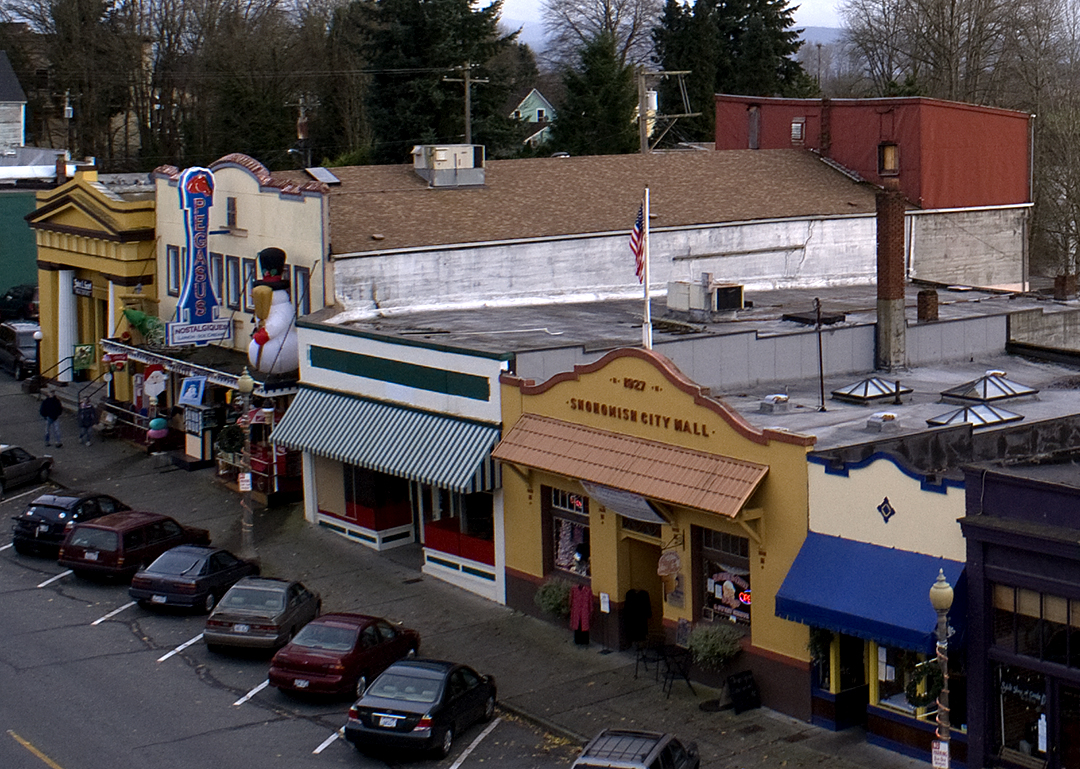 The former theater building on First Street in Snohomish, January 2012, showing the red stage house tower backing up to the river.
The former theater building on First Street in Snohomish, January 2012, showing the red stage house tower backing up to the river.
The historic Lon Brown Theater building, at 1003 First Street, opened on October 9, 1924, with live theater acts and two sold-out screenings of the silent movie, Hold Your Breath, at 7 and 9 pm. Fans spilled out into First Street, blocking traffic … eventually dispersing over the years, it finally closed in 1999.
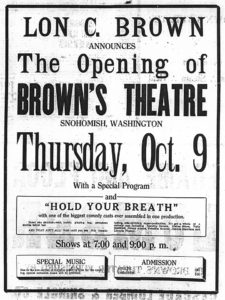 The theater building, fully equipped with a fly loft for raising and lowering scenery, plus dressing rooms for 60 persons, opened with the new millennium as the Pegasus Theatre Shops. A tourist trap kind of place that erased any trace of its previous life holding live theater. The business moved to Las Vegas a couple of years ago leaving behind a run-down building littered with unsold stuff too large to move.
The theater building, fully equipped with a fly loft for raising and lowering scenery, plus dressing rooms for 60 persons, opened with the new millennium as the Pegasus Theatre Shops. A tourist trap kind of place that erased any trace of its previous life holding live theater. The business moved to Las Vegas a couple of years ago leaving behind a run-down building littered with unsold stuff too large to move.
New owners arrived with the new year, 2020, moving the abandoned stuff to the sidewalk to give away, then discovering a dangerously water damaged stage house tower. It was quietly taken down by a small crew that is now building out an 800 square foot perch featuring oversized windows high above the Snohomish River Valley.
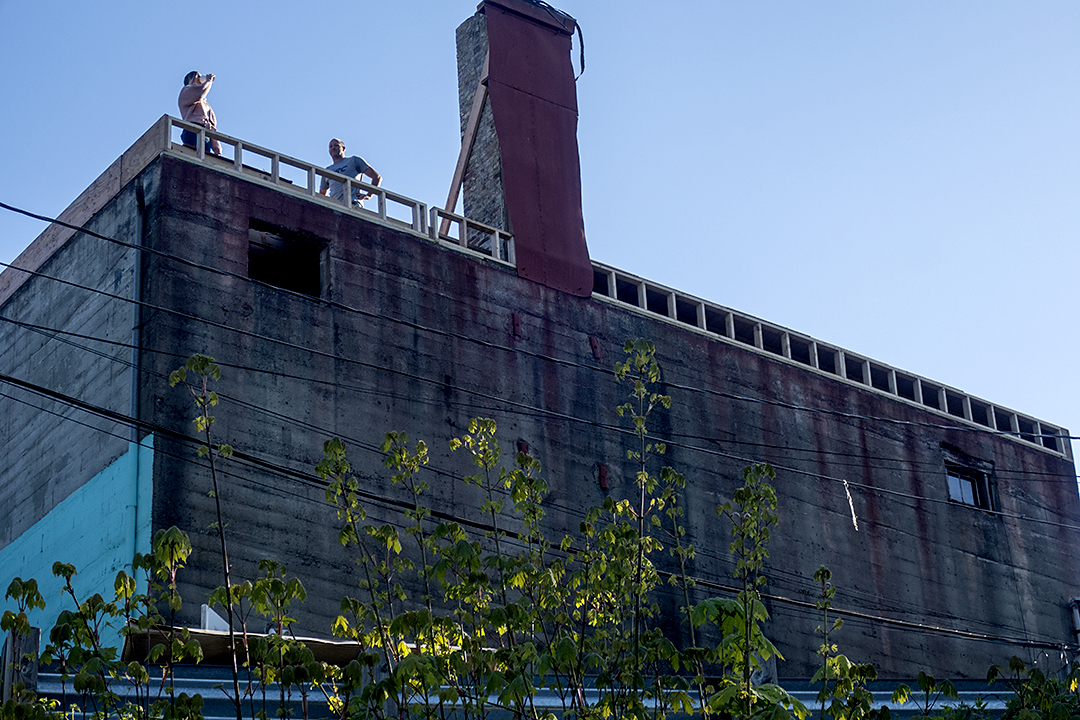 Captured from the River Front Trail on Thursday morning, May 7th with unidentified figures standing on the new roof alongside all that remains of the stage tower wall still attached to the chimmey.
Captured from the River Front Trail on Thursday morning, May 7th with unidentified figures standing on the new roof alongside all that remains of the stage tower wall still attached to the chimmey.
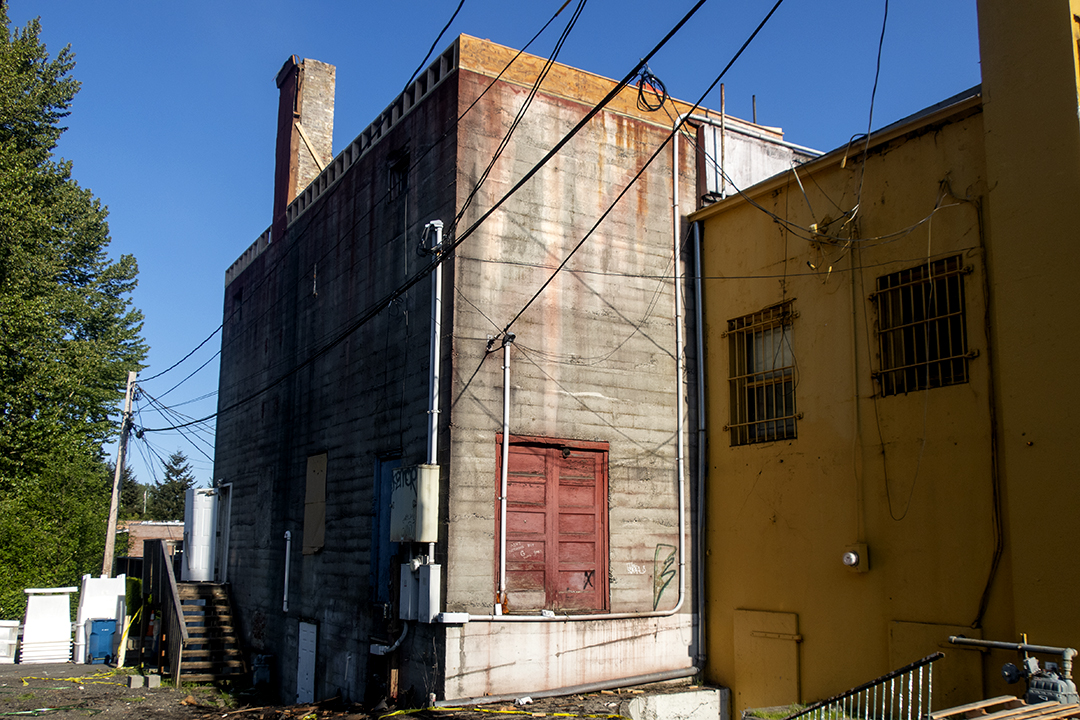 Short alley view off Avenue A showing the backstage double doors for loading scenery.
Short alley view off Avenue A showing the backstage double doors for loading scenery.
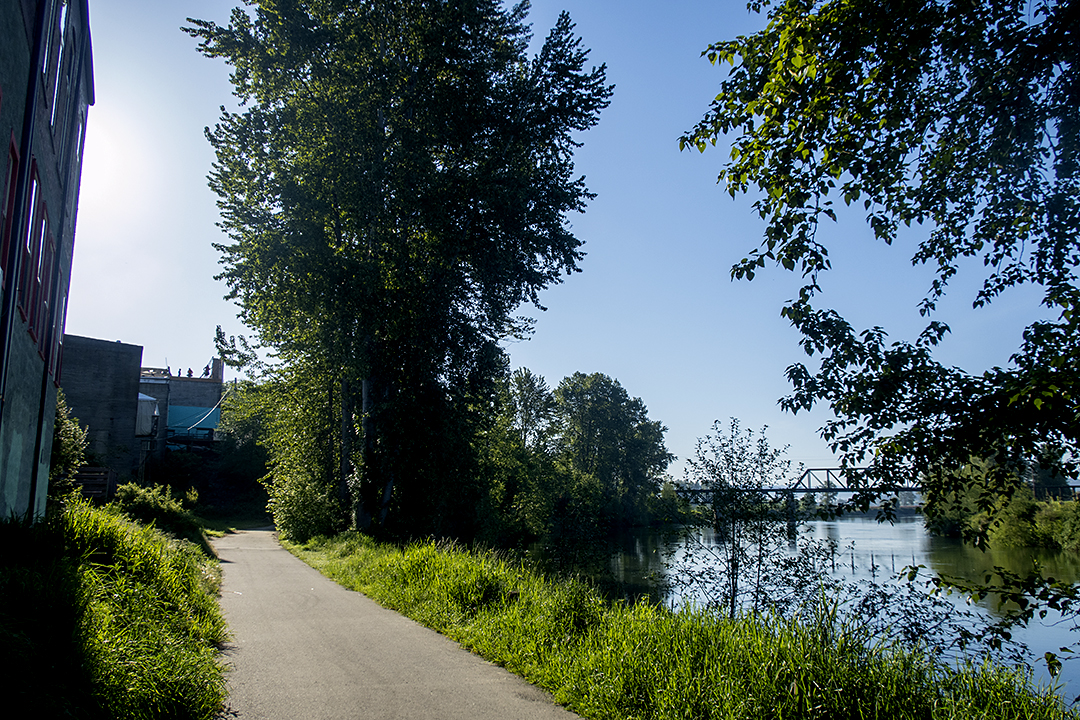 Looking east from the Kla Ha Ya Park showing the small crew working on the stage tower in the horizon.
Looking east from the Kla Ha Ya Park showing the small crew working on the stage tower in the horizon.
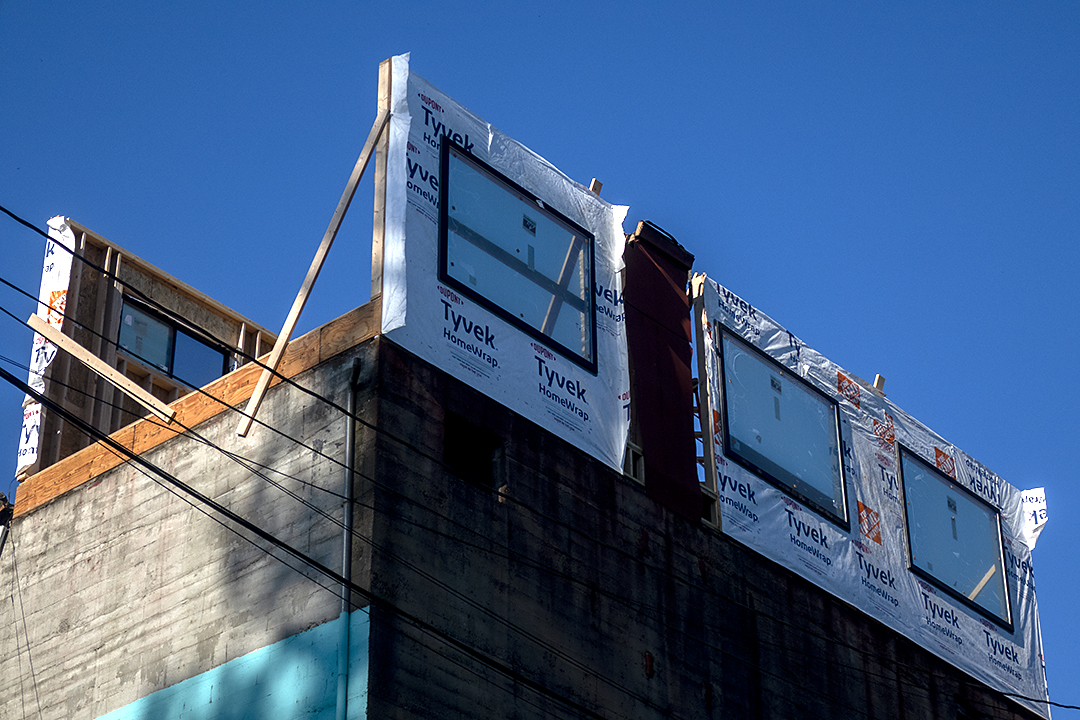 Captured Friday morning, May 8th, showing the oversized windows already in place.
Captured Friday morning, May 8th, showing the oversized windows already in place.
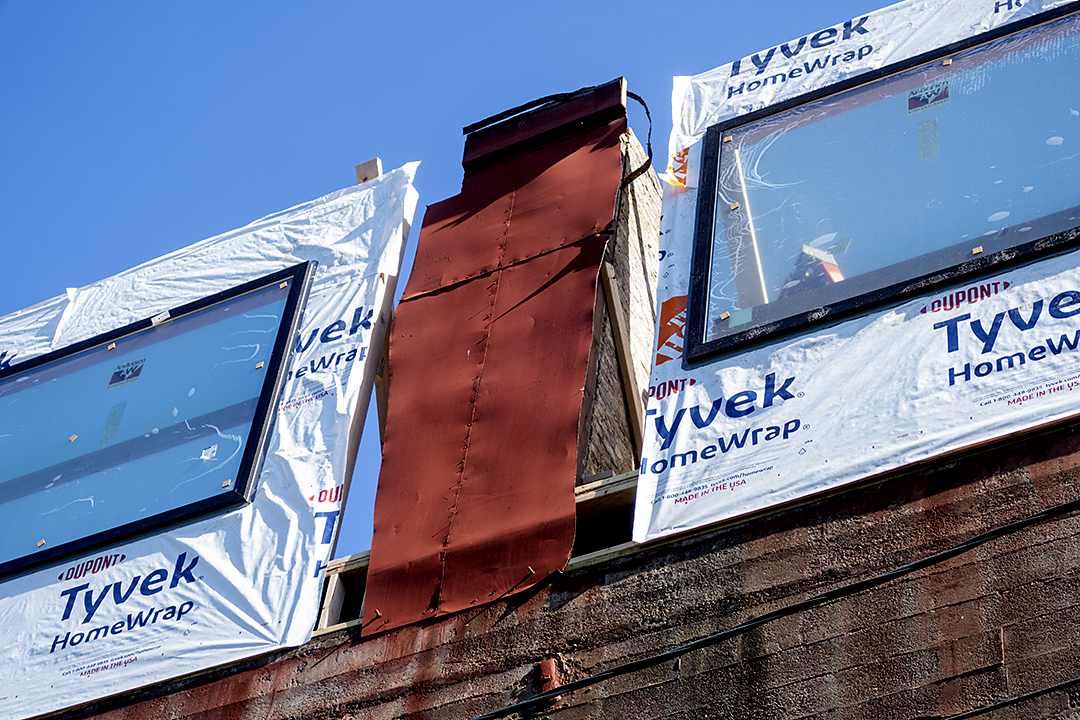 Close up view of what remains of the stage tower wall still attached to the chimmey.
Close up view of what remains of the stage tower wall still attached to the chimmey.
On Friday, May 8th, Sharon Petitt, the city’s Building Inspector, visited the site to met with the contractor when she heard his story of the urgency and reasons for tearing down the stage house tower. Ms. Petitt issued a correction report that a permit is required and Design Review. The owner’s permit was for interior work only.
Owners planning external alterations to their structures located in the Historic District are required to submit their plans to the Design Review Board (DRB), a citizen board charged with maintaining design standards for the district. A copy of the standards is available from city hall or online. The public is invited to all DRB meetings and is encouraged in this case.
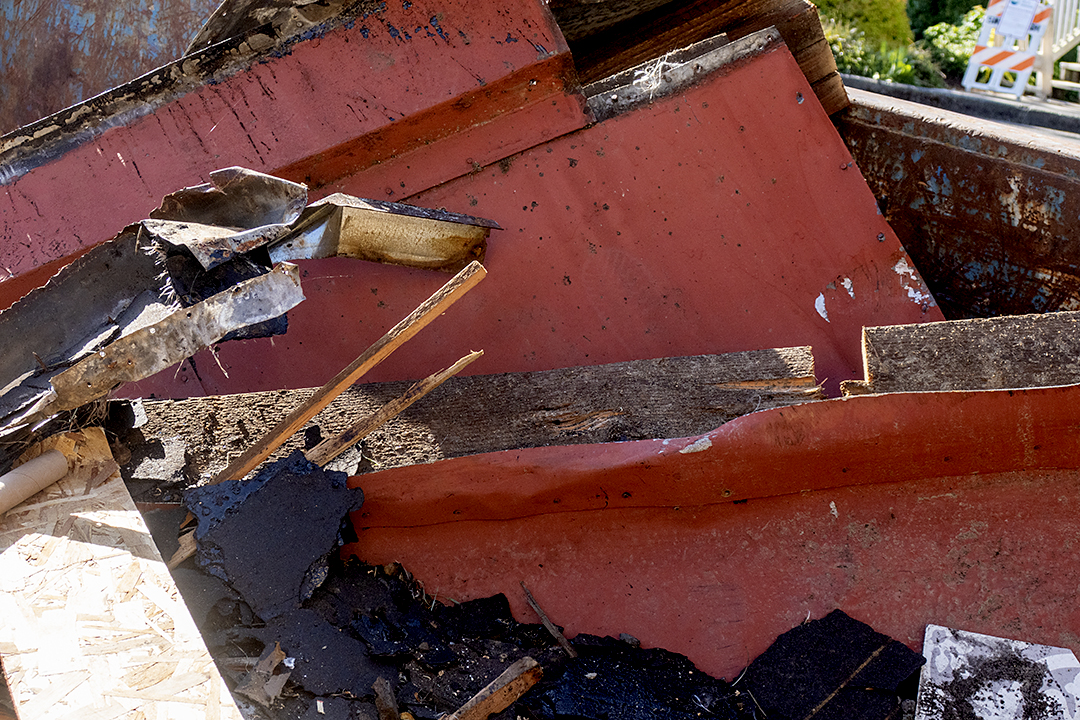 Pieces of the stage house walls of red painted sheet metal in the dumpster.
Pieces of the stage house walls of red painted sheet metal in the dumpster.
Subscribe to Our Tiny Newsletter
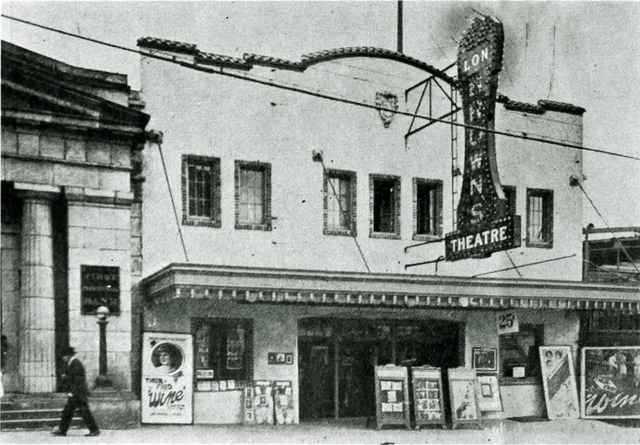 Undated photo of the Lon Brown Theater found on the internet.
Undated photo of the Lon Brown Theater found on the internet.
It’s my understanding that early in its history, the stage welcomed community presentations — I’d love to learn more — please comment below with your experience, or contact me. We will feature your stories in our October post: “Remembering the Lon Brown Theater.” Included as well will be an online screening of the theater’s first movie: Hold Your Breath.
This October, the Lon Brown Theater building will be four years short of its 100th Anniversary.
. . .
FEATURED IMAGE: This beautiful pile of rubble was once the “Annex,” sometimes called the “brick addition,” and formally referred to as the “1968 Addition to the Carnegie Library.” It’s the happiest picture I’ve ever made in my life, so far; and today is my birthday! [#78.]
Yet, this picture brings to mind the mess we made struggling for community acceptance to expose our historic Carnegie building.
This story begins 15 years ago when the Snohomish City Council established the Carnegie Preservation Committee, tasked with recommending an architect who would prepare a feasibility study of bringing new life to our small library building. The addition, built with a $150,000 bond issue approved in 1966, doubled the square footage and added twice the shelf space for books. Opened in 1968, it was again too small twenty years later.
Mayor Payson Peterson accepted the soft ochre brick addition for the city. Washington State librarian, Maryan Reynolds, gave the keynote address followed by a public open house for a proud, contented community. But with a man about to land on the moon, along with more people moving to town, Snohomish’s days of innocence were numbered. The Little Building that Almost Could
The Carnegie Preservation Committee selected BoLa Architecture + Planning, a firm homegrown in Seattle, and the choice was approved by all seven council members. With that done, the selection committee was disbanded. However, several members continued to serve on the board of the Snohomish Carnegie Foundation, a non-profit organization with the mission to establish the Carnegie Educational Center — narrowed down with the tag: A Place for Families, — to be located in the renovated historic building.
Although the BoLa people offered planning services they were not called upon to consider the entire site, just the historic building. It seems the contract with the city called for the firm to essentially ignore the Annex (I know, odd) save for specifying cosmetic repairs once the Annex was separated — standing free and needing a new face.
Consequently, the city council asked the Foundation to pay for a feasibility study of what to do with the Annex: sell it to a third party; fix it up and rent it out at market rate; or demolish it. Working with two independent consultants, the three options were presented to the council members.
The third option was accepted by a unanimous vote: to demolish the Annex and create a downtown park. The year was 2008, yet the Annex stood, and stood, still attached to the historic building until February 18, 2020, a Tuesday.
A Leader Founds a FacebookGroup of Responsible Citizens
Snohomish residents grew increasingly restless during this time. Our police chief expressing his love for another male officer in an email was only the beginning.
He resigned and with the new chief the heretical discussion resumed — to contract with the county sheriff and dissolve the entity known as the Snohomish Police Department.
Residents imagined (so no need for facts) the worse: “Our police department is 150 years old!” claimed a misinformed malcontent in a letter to the editor.
When discussing the future of the Snohomish Police Department, let’s be clear about its past — the department is not 150 years old. Looking for the beginning of a paper trail establishing our Police Department led me to the unexpected discovery that legally, the entity called “The Snohomish Police Department” is only 38 years old.
Part 4: Snohomish Police Department.
Looking back, we should have known that the founder of a Facebook group for Snohomish residents practicing willful ignorance – would be the wellspring from which the Leader of the group emerged disguised as a humble truck driver.
At the time, I avoided looking into his eyes, his stare was troubling. He appeared to be a homeless person. My first encounter was at the door of our home, he rambled on about a donation of a historic home that appeared to be abandoned? (Karen and I looked at each other as he walked through the garden gate — how bizarre we both thought — but then non-followers don’t see a Leader.)
Odd too, he was a person of mixed race in a white town; moreover, he came with an incredible story, (learned later, towards the end), that his mother told him his father was white – until he was 10 years old. (So the story goes, yet, it’s a genesis story worthy of a Founding Leader.)
His Facebook Group was growing in members as the restlessness of the community facebooked each other up with the gall of a developer even applying to build small apartments (referred to as apodments) in a neighborhood of single-family homes. Apodments were successful for this developer in Seattle where a half dozen small studios share a kitchen – like a family.
The horror of who-would-live-in-such-a-place stuffed the city council chambers with the largest numbers yet of the gloriously uninformed. One speaker, I remember, stepping up to the lectern testified he was afraid for the family cat! I assumed the man imagined the family pet would be seen as food by people who didn’t want to pay for a normal-sized home. Who knows?
The timeline is fuzzy as it seems like everything was happening at once back in those days. Like out of nowhere came the horror of a cell-tower-in-a-park. An enterprising malcontent even built a mock-up of how tall the proposed tower would be compared to what I don’t remember.
The park in question was once an empty lot alongside the railroad tracks and where, over the years, was born a baseball park of community fraternity. Moreover, from this homegrown park, a tribute to the fertile American past time came Earl Averill: the first rookie in major league history to score a home run his first-time at-bat. Locating Home Plate
The ballpark was named Averill Field around the time Earl was inducted into the Baseball Hall of Fame – Earl is Snohomish’s most famous citizen – even though the ballpark with its homemade stadium seating and lighting towers eventually returned to its beginnings as a vacant lot. For many years afterward, the annual carny rides would use the lot for one week in July.
The outdoor swimming pool was the first thing built on the sacred site, which was eventually brought indoors by the Snohomish School District and named after the revered Superintendent, Hal Moe.
Next, the Kiwanis club finally built a modern playground for kids – a design unimagined by the founders of the Playground Association. Then a skatepark (smoothly poured concrete ritual sites built in even the smallest towns during those days) and finally, the Boys and Girls Club filled out the park known as Averill Field.
Which brings us back to the horror story of the huge cell tower, which was proposed by the city to be tucked in behind the Boys and Girls Club.
Then, the Leader discovered a covenant in the deed of the park lots: #for_playground_purposes_only!
With this imagined coup, the Leader mounted an imaginary white horse and carried a dark banner that read: “Restore the Deed.” From this perch, he led a movement to change the city’s government which would restore the strong mayor — one who lived in Snohomish, (rather than a city manager who lived somewhere on the way to Seattle).
The Leader’s #1 Boy Follower went door-to-door twice, first to gather signatures required to hold an election for the change, and a second time to gather support for his run as the strong mayor. The Leader and his #1 Boy Follower won both elections, even though the Leader’s #1 Boy Follower had not a lick of elected experience. He had never served on a commission. His only city government experience was yelling at council members during his time at the lectern.
The Boy Mayor
Just as the city staff released plans to give the Annex lobby a quick facelift if the 1910 Social Hall was to hold city council meetings — the flat roof of the Annex failed — no one was allowed inside.
Consequently, the city took over ownership of the property determined unsafe, a possible danger to the public. This got people’s attention. Funds were found, a new architectural firm was hired to (again) study what should be done with the (now leaking) Annex!
The numbers required to save the Annex was a million-dollar story. This didn’t stop the Leader, if he had even heard the news. He was still riding around town on his white horse while his followers stayed close to their computer keyboards rather than attend a town hall meeting at the new Aquatic Center.
Following the Leader’s presentation to save the Annex, a member of the audience asked those in attendance for a show of hands: “how many want the Annex removed?” An overwhelming majority of hands shot up.
The Leader’s fantasy plan went down with a cheer, then a second louder cheer when The Leader left the room. He was still on his horse, nearly banging his head on the door jamb.
Word has it that he is living in Texas, but who knows?
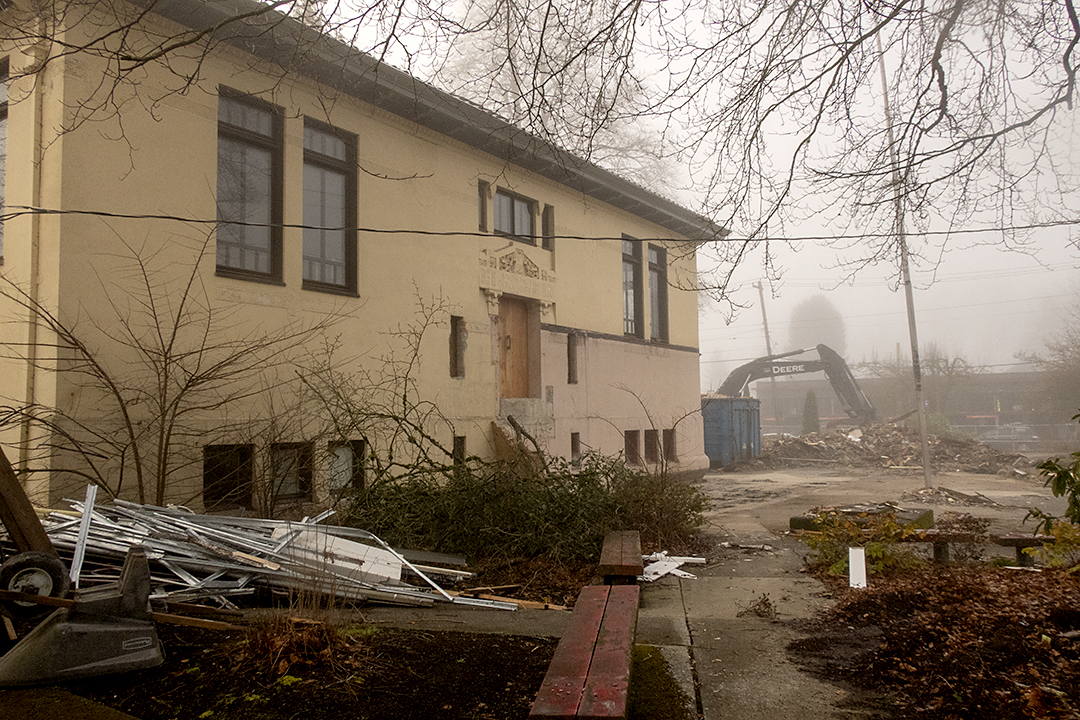 Captured 03.09.20 around 8:30a. The pile of rubble is smaller.
Captured 03.09.20 around 8:30a. The pile of rubble is smaller.
. . .
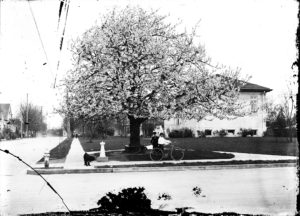 The historic image in the animation is an undated glass plate negative of the famous cherry tree, which appears to be in bloom. (Courtesy Snohomish Historical Society.)
The historic image in the animation is an undated glass plate negative of the famous cherry tree, which appears to be in bloom. (Courtesy Snohomish Historical Society.)
The oldest element in our historic town is pretty much ignored most days until it flows free of its boundaries — then we come to watch the Snohomish River.
Over the years, I have adopted Kla Ha Ya Park, a riverfront park below First Street between Avenues B and C in Historic Downtown Snohomish, as a place to practice Tai Chi. For me, it’s a place to appreciate the historic beginnings of our town, and I’m not alone these days. Since the flooding began on the winter solstice (pictured above), people have been coming to check out the rising river. Some stand with their toes right up to the edge, others further back to snap a wide shot to share on social media.
On Sunday morning, the second day of February, I went a step further and set up my camera to capture my practice of Tai Chi alongside the rushing river several feet above the riverfront trail, and very close to my spot of green in the park
Our riverfront park with the odd name translated as Welcome is the proud product of community action rising up from the destructive powers of fire and water.
The first commercial buildings of 19th-century Snohomish were built of wood and on the riverside of Front Street, the buildings were built on tall wooden pilings, some 20 feet high, in order to bring the structures up to the street level.
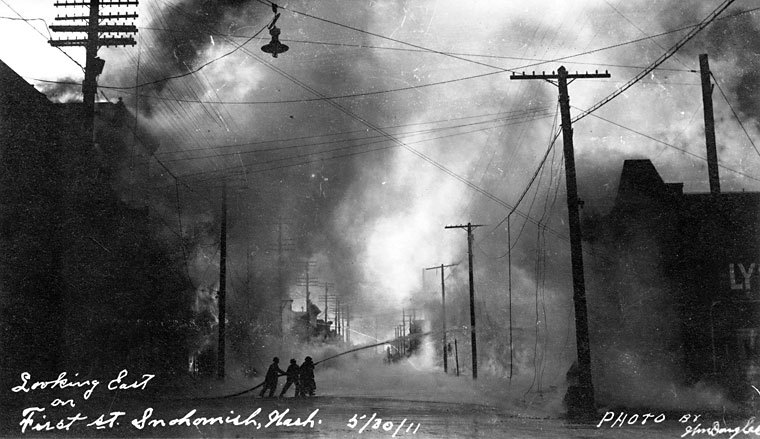
The Great Fire of 1911 destroyed all the buildings on both sides of the street between Avenues B and C. As if named from a Dickenson novel, the three-story Burns Block at 1118 First Street built of brick in 1890, stopped the fire and saved the two wooden buildings still standing as neighbors to this day.
Read: The Building That Stopped a Fire!
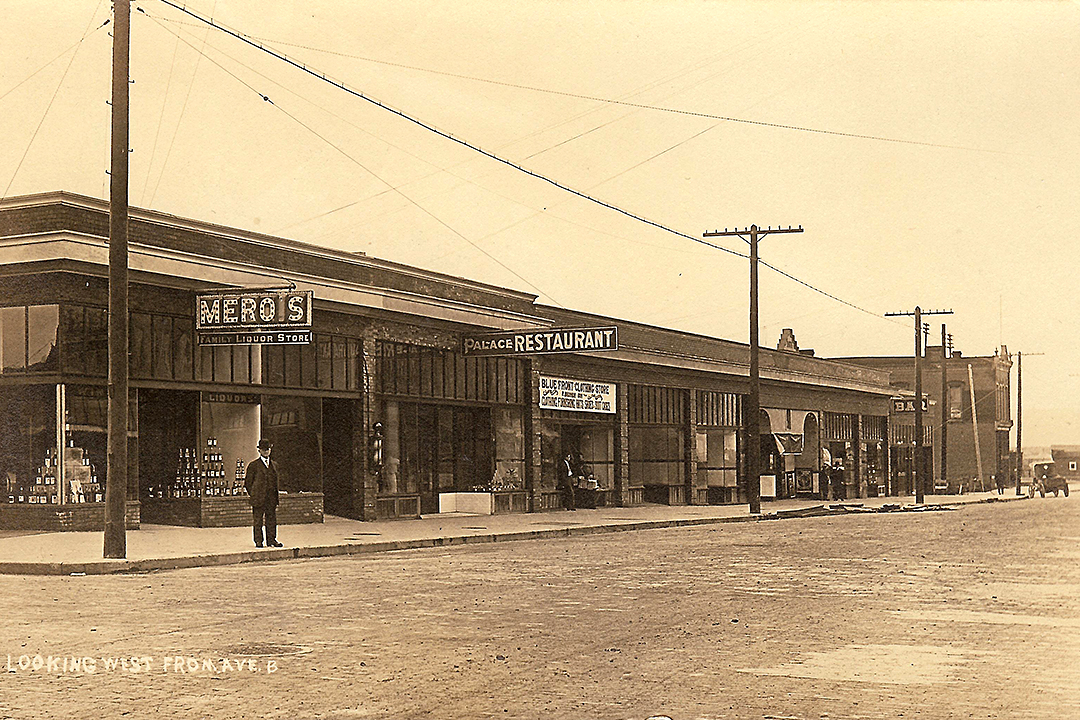
Block 2 rebuilt of brick, courtesy David Dilgard, Northwest Room, EPL.
Both sides of the street were quickly rebuilt of brick, the south side completely (pictured above). Snohomish was railroad rich around this time as the Milwaukee Road had just begun passenger service on its line running on a trestle built over the north bank. The building at the far end of the photograph was the former Wilbur Drug Store, which became a train depot.
Instead of wooden pilings, the brick buildings were brick all the way down to the foundation, and flooding over the years weakened the brick foundations. In the early 1940s, the liquor store, and the restaurant had become home to Poier Motors, the local Chevrolet dealer in town and a floor displaying a new model collapsed toward the river, nearly killing an employee. The entire block of brick buildings was condemned immediately. The storefront structures remained vacant for over 15 years.
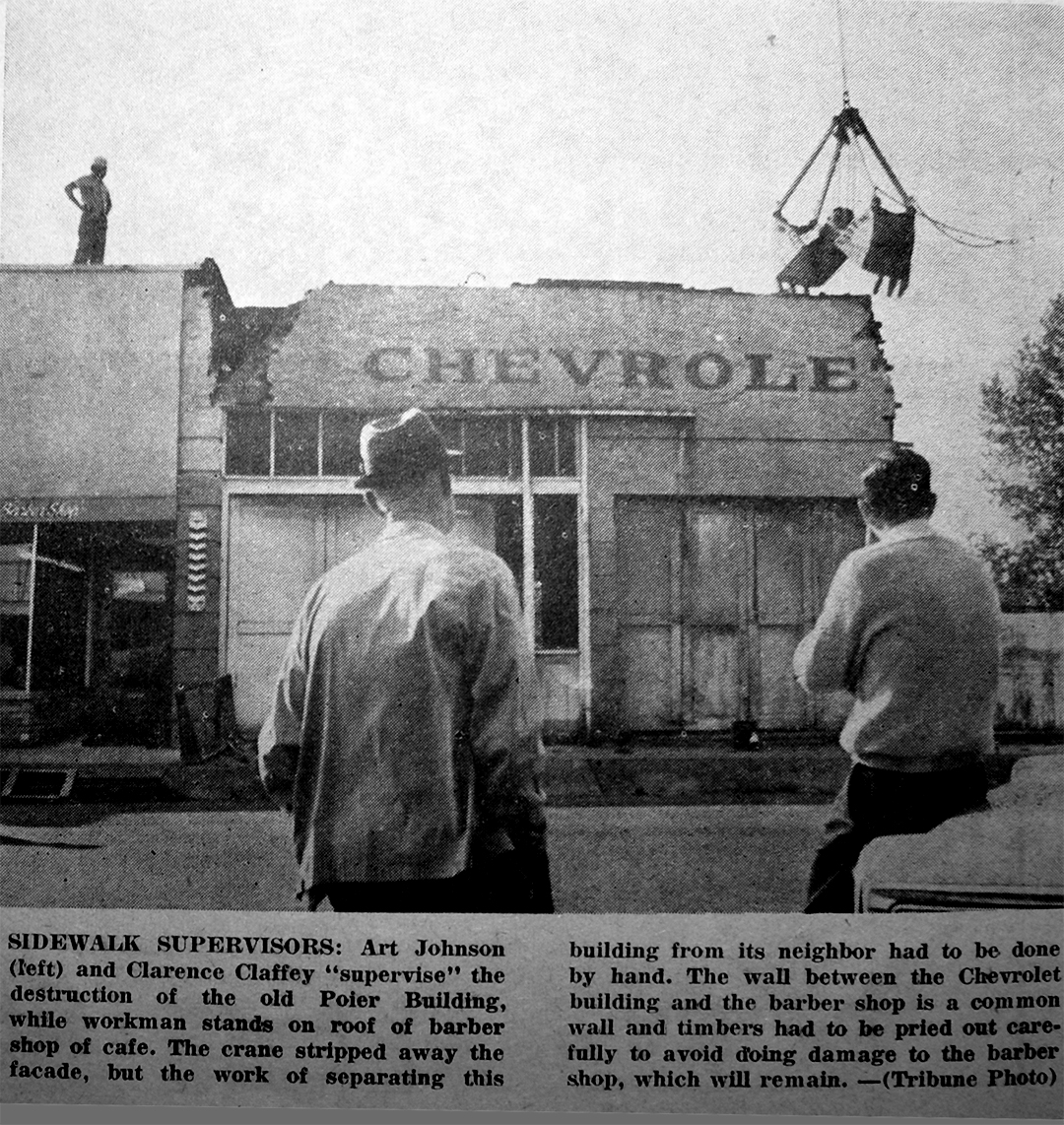
It was not until 1965 that funds were appropriated to finally tear down the abandoned structures and community groups rallied to create a riverfront park.
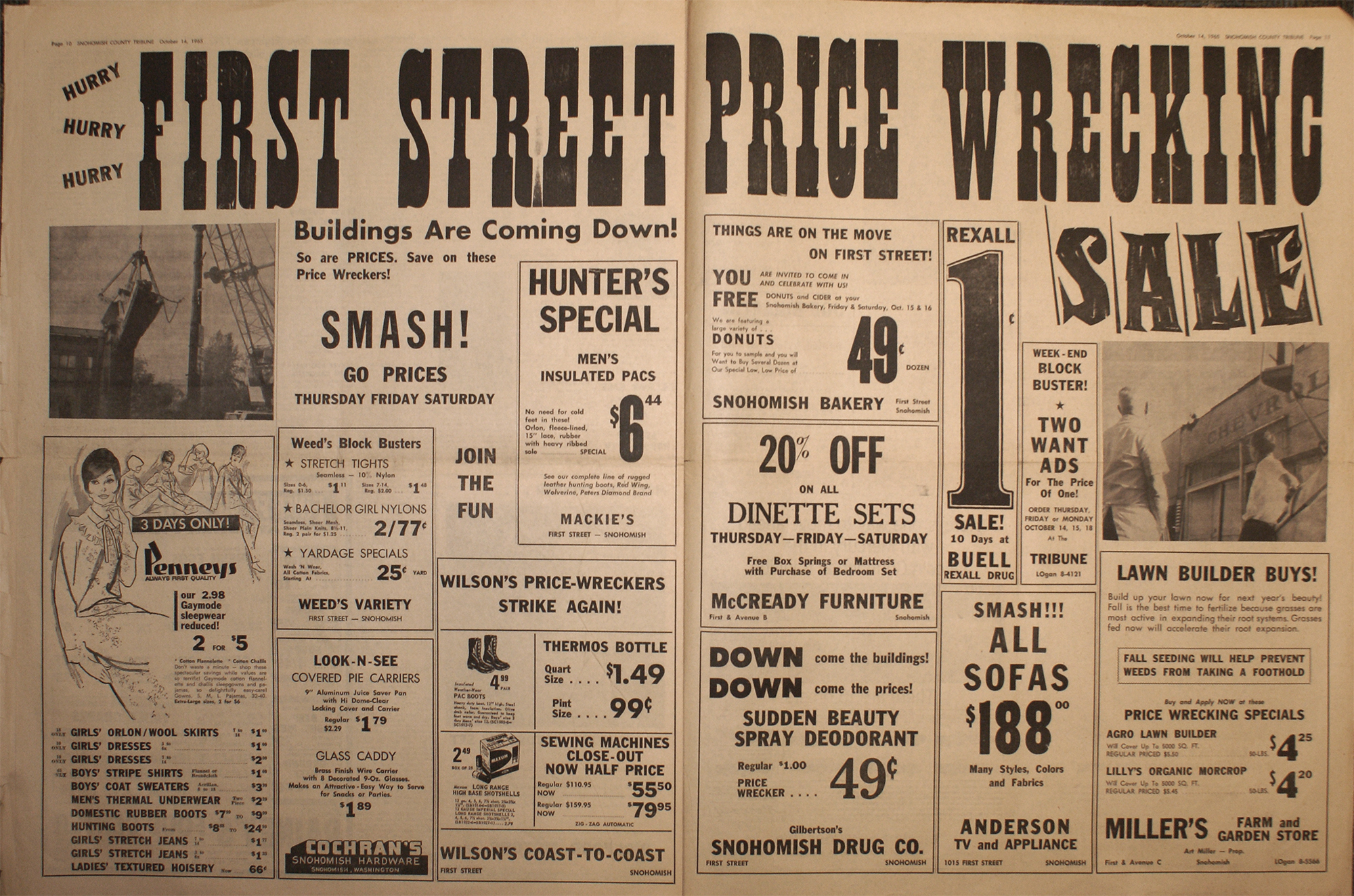
We imagine the former editor of the Tribune, Bill Bates, sold this ad idea to the business community.
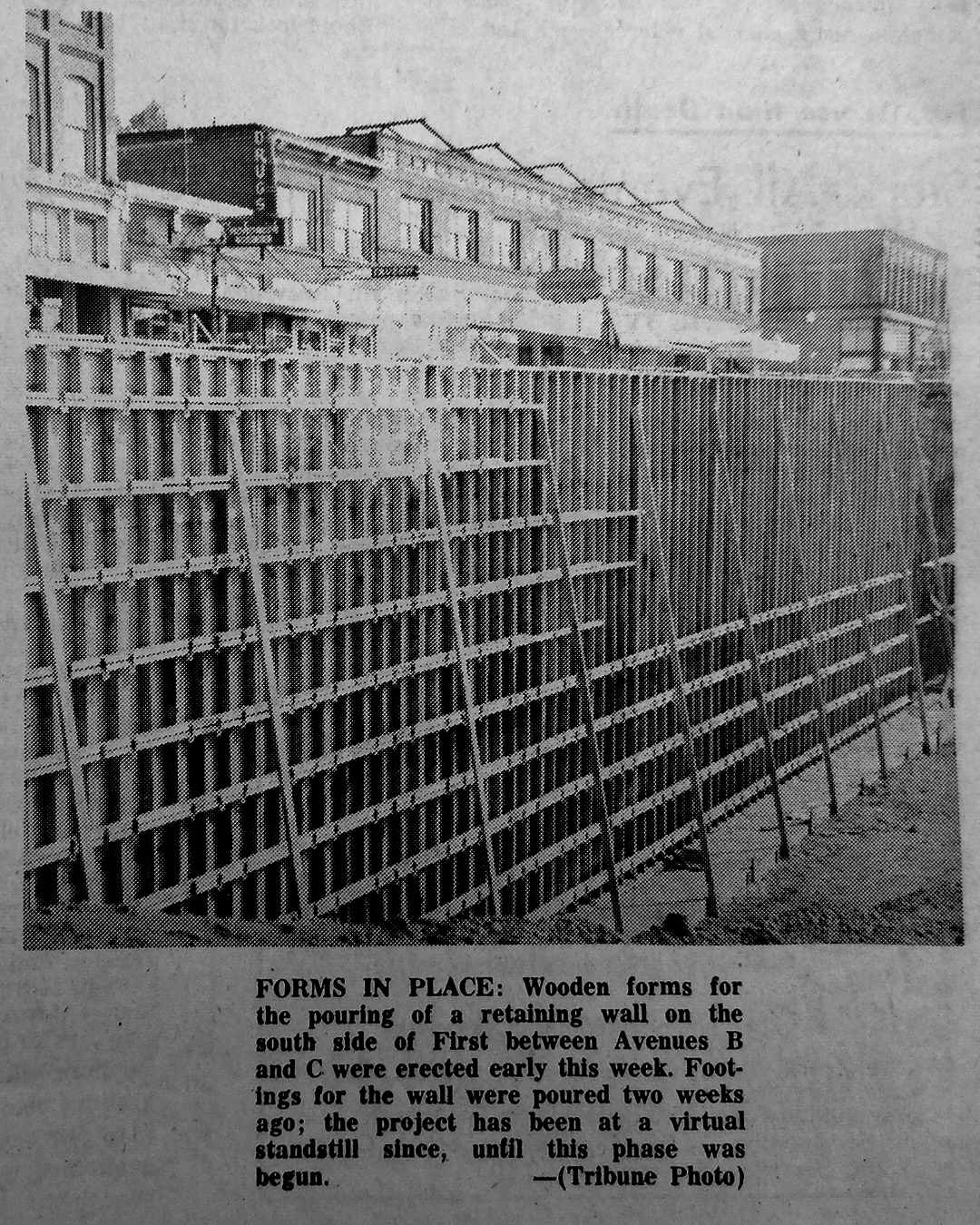
Published in the Tribune, date unknown.
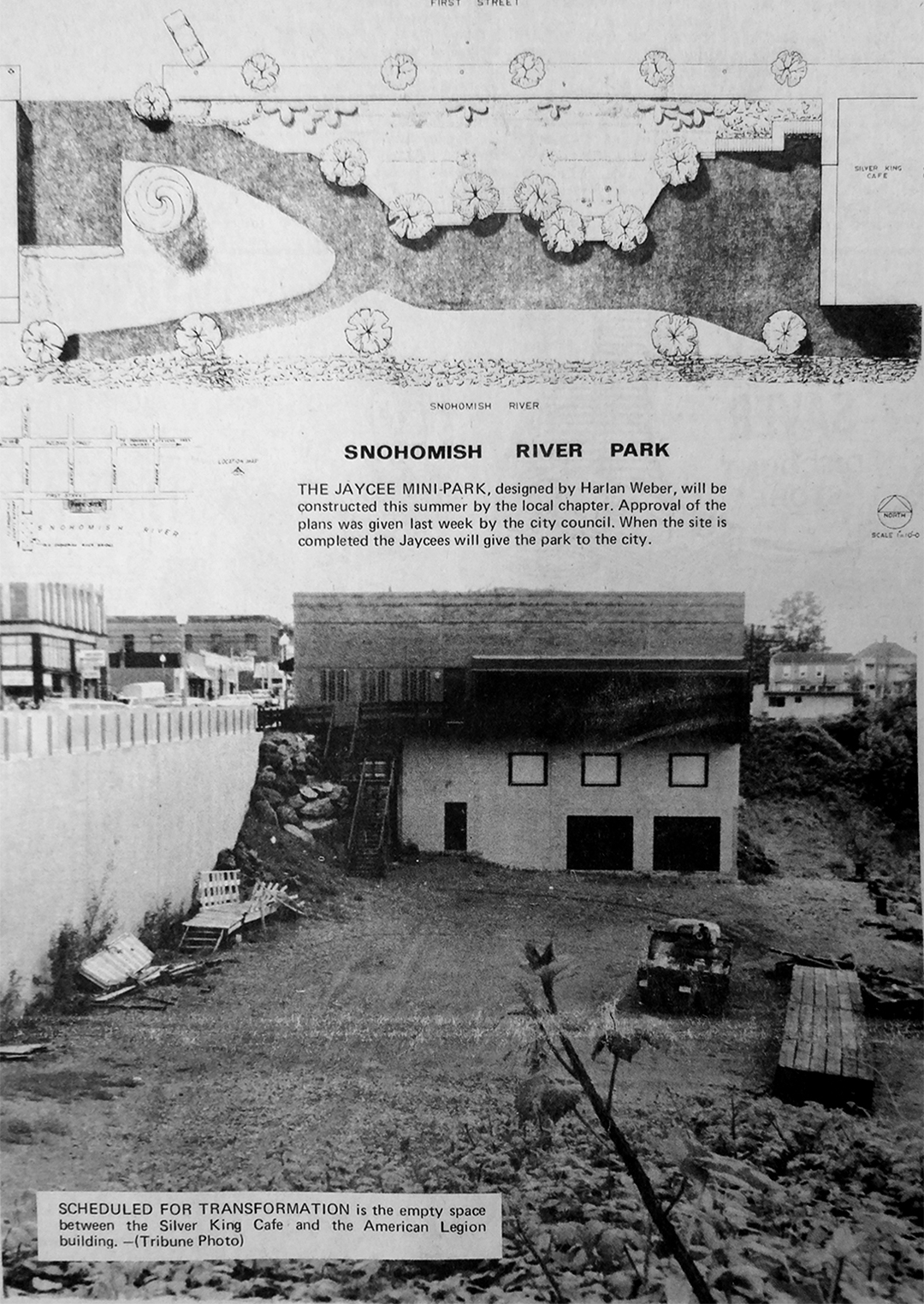
Front page photo published in the May 25, 1972 issue of the Tribune.
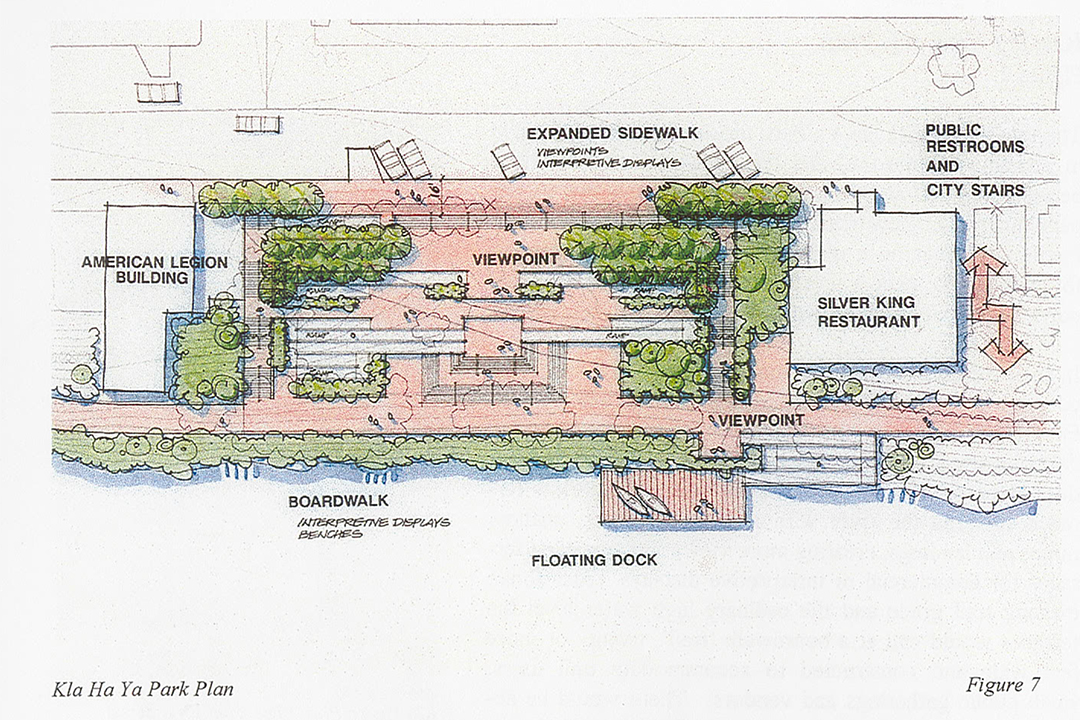
The River Front Trail, such as it was, was severly damaged in the 1995 flood which led to the master plan linked below. The plan includes this sketch for Kla Ha Ya Park that would feature sitting areas and ramps leading down to the water.
Download: 1998 Snohomish Riverfront Master Plan, Kla Ha Ya Park discussion begins on page 29.
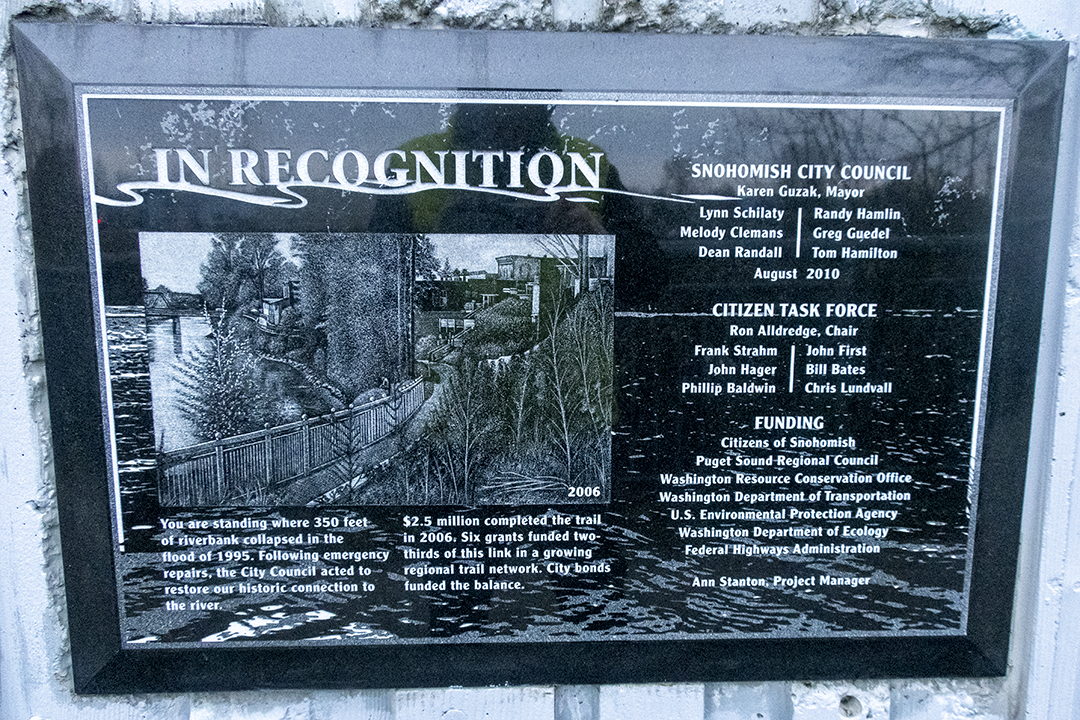
One of several informative plaques on the Riverfront Trail, which was based on the master plan, the trail as we know it today opened in 2006.
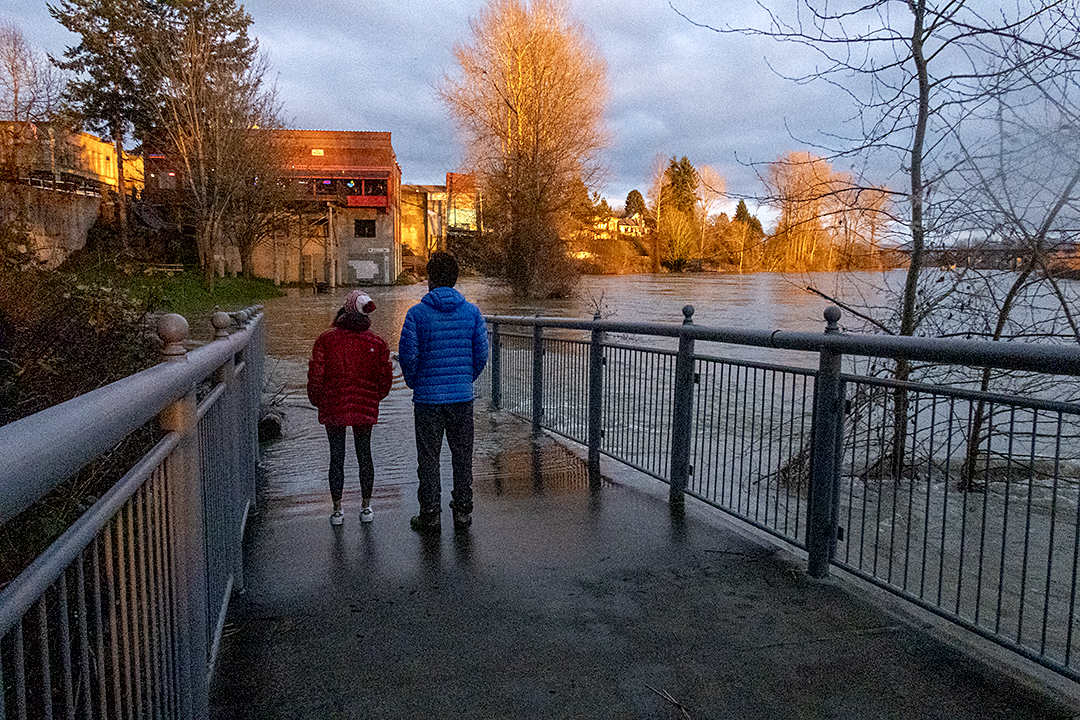
Captured Saturday, February 8th from the ramped section of the trail that is meant to honor the history of the railroad that once followed this route on a wooden trestle.
You are invited to an impromptu preview of all nine signs designed for the heritage trail on Sunday, October 13th, from 4 to 6p. at the AngelArmsWorks Studio, 230 Avenue B in Snohomish.
Inexpensive full-size prints of the signs are on display for a week while we fine-tune the designs. The image above is from our first preview on Sunday the 6th. The purpose of the preview is to receive feedback on the readability of the stories, and our first preview was very encouraging.
The sub-title of the project, or the tag-line if you will is, “Short Stories of Those Who Came Before Us.” My intention is for visitors to be drawn into the signs but stay to read the story and learn about the people who made Snohomish.
All good stories go with a glass of wine which I’m happy to provide.
Hope to see you on Sunday the 13th, around 4p.
(Karen’s handmade tote bags will be hanging around too.)
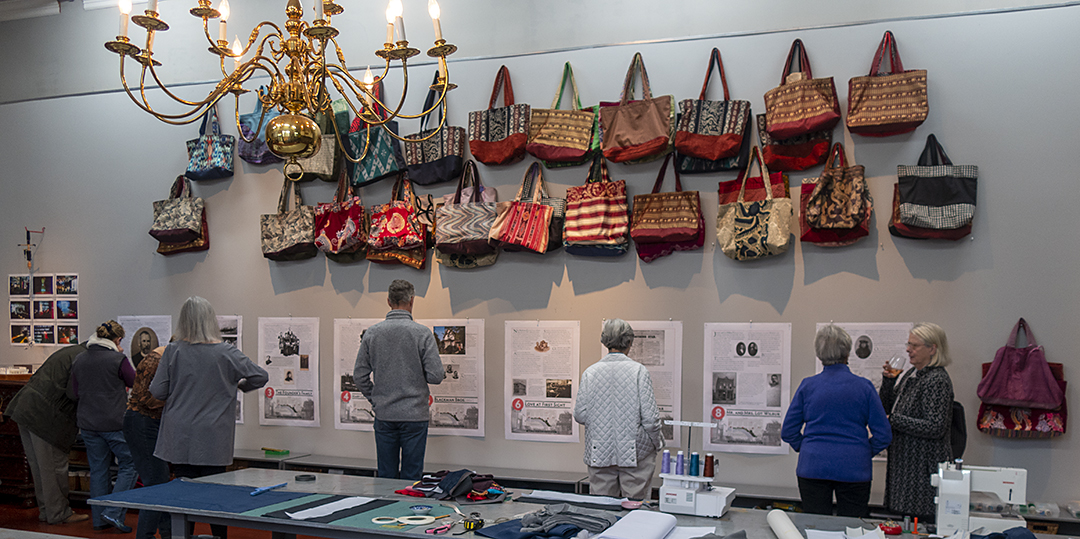
Thanks to all who showed up to preview the signs — got lots of useful suggestions, and thanks to Karen for the delicious lasagne supper!